
| Version | Summary | Created by | Modification | Content Size | Created at | Operation |
|---|---|---|---|---|---|---|
| 1 | Rita Xu | -- | 4033 | 2022-09-29 01:33:15 |
Video Upload Options
Historically, all Chinese swords are classified into two types, jian and dao. Jians are double-edged straight swords while daos are single-edged, and mostly curved from the Song dynasty forward. The jian has been translated at times as a long sword, and the dao a saber or a knife. Bronze jians appeared during the Western Zhou period and switched to wrought iron and steel during the late Warring States period. In modern times, the ceremonial commissioned officer's sword of the Chinese navy has been patterned after the traditional jian since 2008. Other than specialized weapons like the Divided Dao, Chinese swords are usually 70–110 cm (28–43 in) in length, although longer swords have been found on occasion. Outside of China, Chinese swords were also used in Japan from the third to the sixth century AD, but were replaced with Korean and native Japanese swords by the middle Heian era.
1. Bronze Age: Shang Dynasty (C. 1200 BC–c. 1046 BC) to Spring and Autumn Period (771–476 BC)

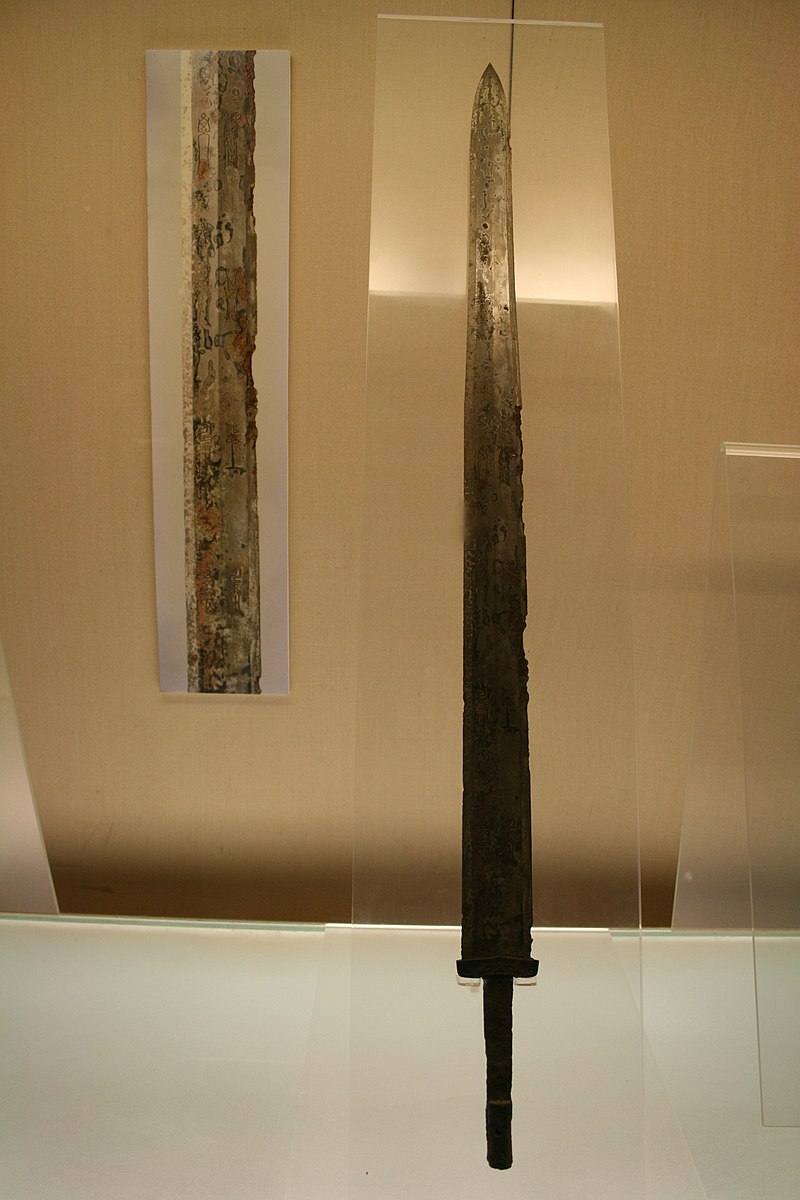

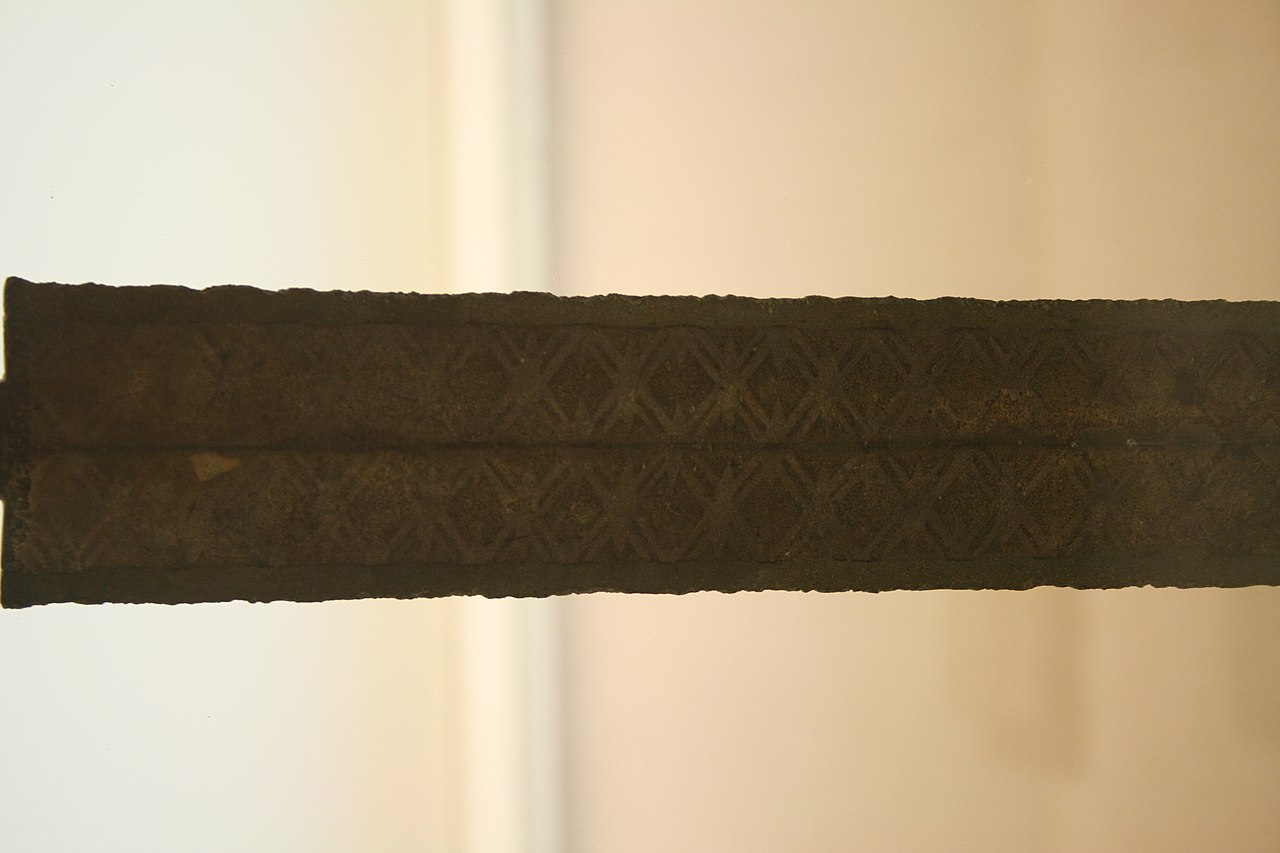

Knives were found in Fu Hao's tomb, dated c. 1200 BC.[1]
Bronze jians appeared during the Western Zhou. The blades were a mere 28 to 46 cm long. These short stabbing weapons were used as a last defense when all other options had failed.[2]
By the late Spring and Autumn period, jians lengthened to about 56 cm. At this point at least some soldiers used the jian rather than the dagger-axe due to its greater flexibility and portability.[2] China started producing steel in the 6th century BC, but it was not until later on that iron and steel implements were produced in useful amounts.[3] By around 500 BC however the sword and shield combination began to be regarded as superior to the spear and dagger-axe.[4]
1.1. Legendary swords
According to the Yuejue shu (Record of Precious Swords), the swordsmith Ou Yezi forged five treasured swords for Gan Jiang and King Zhao of Chu, named, respectively, Zhanlu (湛盧), Juque (巨闕), Shengxie (勝邪), Yuchang (魚腸) and Chunjun (純鈞). He also made three swords for King Goujian of Yue, named Longyuan (龍淵), Tai’e (泰阿) and Gongbu (工布).
- Chungou/Chunjun (Purity) - Its patterns resembled a row of stars in a constellation.[5]
- Zhanlu/Pilü (Black) - A sword made from the finest of the five metals and imbued with the essence of fire. It was said to be sensitive to its owner's behaviour and left of its own accord for the state of Chu when Helü's conduct offended it. When Helü became aware of King Zhao of Chu's possession of Zhanlu, he attacked Chu.[6]
- Haocao/Panying (Bravery/Hard) - Said to have been imbued with the aspect of lawlessness and was therefore of no use to anyone. It was used as a burial object.[7]
- Yuchang (Fish Belly) - A short dagger said to be capable of cleaving through iron as if it were mud. Used by Helü of Wu to assassinate his uncle, Liao of Wu. It was hidden in a cooked fish presented to King Liao at a banquet. As a result it gained a reputation for causing its user to be disloyal.[8]
- Juque (Great Destroyer) - Said to be incredibly durable, being able to withstand even hitting or stabbing rock.[9]
- Shengxie (Victor over Evil)
- Longyuan (Dragon Gulf) - Its shape resembled that of a high mountain and a deep gulf. Goujian used it to cut a gash in his thigh as self-punishment when he mistakenly executed an innocent person.[10]
- Taie (Great Riverbank) - Had patterns like the waves of a flowing river. Was used by the king of Chu to direct his army against a Jin invasion.[10]
- Gongbu (Artisanal Display) - Had patterns like flowing water that stop like pearls at the spine.[10]
2.2. Gan Jiang and Mo Ye
According to the Spring and Autumn Annals of Wu and Yue, Ou Yezi was also the teacher of Gan Jiang, who was married to Mo Ye. King Helü of Wu ordered Gan Jiang and Mo Ye to forge a pair of swords for him in three months. However, the blast furnace failed to melt the metal. Mo Ye suggested that there was insufficient human qi in the furnace so the couple cut their hair and nails and cast them into the furnace, while 300 children helped to blow air into the bellows. In another account, Mo Ye sacrificed herself to increase human qi by throwing herself into the furnace. The desired result was achieved after three years and the resulting two swords were named after the couple. Gan Jiang kept the male sword, Ganjiang, for himself and presented the female sword, Moye, of the pair to the king. The king, already upset that Gan Jiang had failed to supply the swords in three months, but three years, became enraged when he discovered the smith had kept the male sword, and thus had Gan Jiang killed.
Gan Jiang had already predicted the king's reaction, so he left behind a message for Mo Ye and their unborn son telling them where he had hidden the Ganjiang Sword. Several months later, Mo Ye gave birth to Gan Jiang's son, Chi (赤), and years later she told him his father's story. Chi was eager to avenge his father and he sought the Ganjiang Sword. At the same time, the king dreamed of a youth who desired to kill him and placed a bounty on the youth's head. Chi was indignant and, filled with anguish, he started crying on his way to enact his vengeance. An assassin found Chi, who told the assassin his story. The assassin then suggested that Chi surrender his head and sword, and the assassin himself will avenge Ganjiang in Chi's place. He did as told and committed suicide. The assassin was moved and decided to help Chi fulfill his quest.
The assassin severed Chi's head and brought it, along with the Ganjiang sword to the overjoyed king. The king was however uncomfortable with Chi's head staring at him, and the assassin asked the king to have Chi's head boiled, but Chi's head was still staring at the king even after 40 days without any sign of decomposition, thus the assassin told the king that he needed to take a closer look and stare back in order for the head to decompose under the power of the king. The king bent over the cauldron and the assassin seized the opportunity to decapitate him, his head falling into the cauldron alongside Chi's. The assassin then cut off his own head, which also fell into the boiling water. The flesh on the heads was boiled away such that none of the guards could recognize which head belonged to whom. The guards and vassals decided that all three should be honoured as kings due to Chi and the assassin's bravery and loyalty. The three heads were eventually buried together at Yichun County, Runan, Henan, and the grave is called "Tomb of Three Kings".[11][12]
2. Warring States Period (475–221 BC)
Iron and steel swords of 80 to 100 cm in length appeared during the mid Warring States period in the states of Chu, Han, and Yan. The majority of weapons were still made of bronze but iron and steel weapons were starting to become more common.[3] By the end of the 3rd century BC, the Chinese had learned how to produce quench-hardened steel swords, relegating bronze swords to ceremonial pieces.[13]
The Zhan Guo Ce states that the state of Han made the best weapons, capable of cleaving through the strongest armour, shields, leather boots and helmets.[14]
Wu and Yue swords
During the Warring States period, the Baiyue people were known for their swordsmanship and producing fine swords. According to the Spring and Autumn Annals of Wu and Yue, King Goujian met a female sword fighter called Nanlin (Yuenü) who demonstrated mastery over the art, and so he commanded his top five commanders to study her technique. Ever since, the technique came to be known as the "Sword of the Lady of Yue". The Yue were also thought to have possessed mystical knives embued with the talismanic power of dragons or other amphibious creatures.[15]
The Zhan Guo Ce mentions the high quality of southern swords and their ability to cleave through oxen, horses, bowls, and basins, but would shatter if used on a pillar or rock. Wu and Yue swords were highly valued and those who owned them would hardly ever use them for fear of damage, however in Wu and Yue these swords were commonplace and treated with less reverence.[16] The Yuejue shu (Record of Precious Swords) mentions several named swords: Zhanlu (Black), Haocao (Bravery), Juque (Great Destroyer), Lutan (Dew Platform), Chunjun (Purity), Shengxie (Victor over Evil), Yuchang (Fish-belly), Longyuan (Dragon Gulf), Taie (Great Riverbank), and Gongbu (Artisanal Display). Many of these were made by the Yue swordsmith Ou Yezi.[10]
Even after Wu and Yue was assimilated into larger Chinese polities, memory of their swords lived on. During the Han dynasty, Liu Pi King of Wu (195-154 BC) had a sword named Wujian to honour the history of metalworking in his kingdom.[17]
3. Qin Dynasty (221–206 BC)
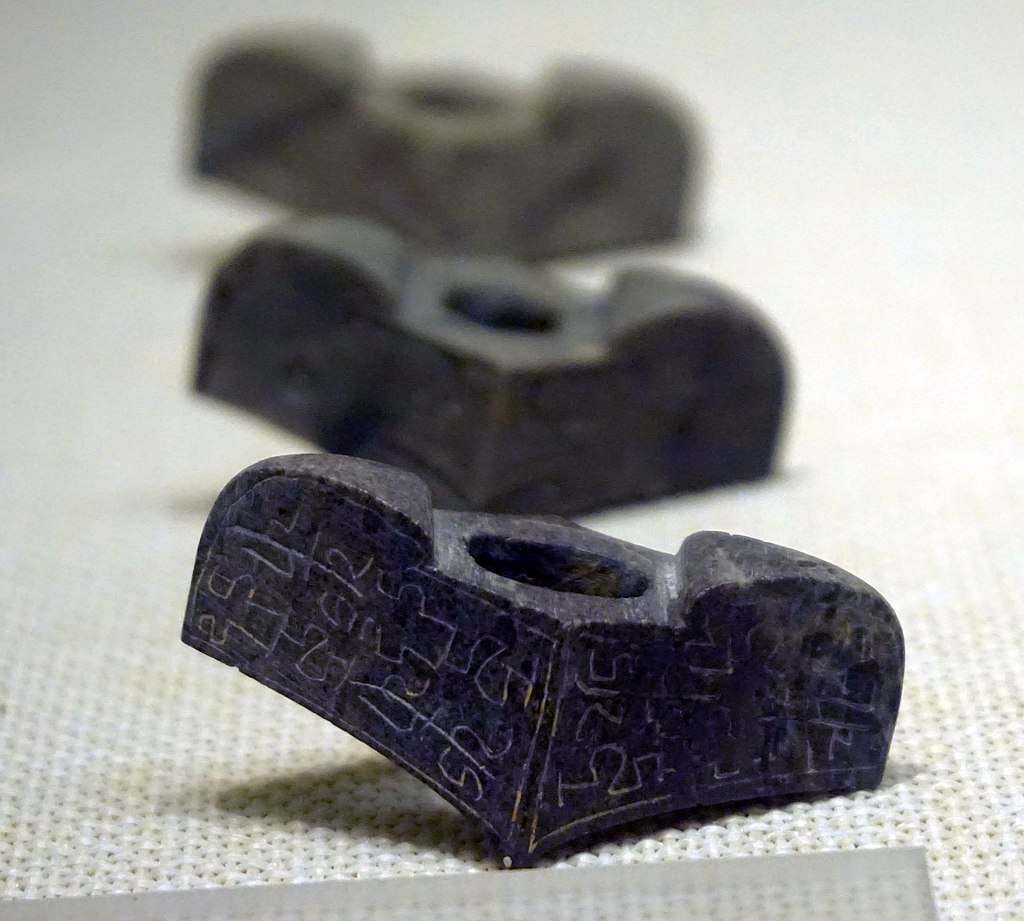
Sword dances are first mentioned shortly after the end of the Qin dynasty.[18] Swords up to 110 cm in length began to appear.[19]
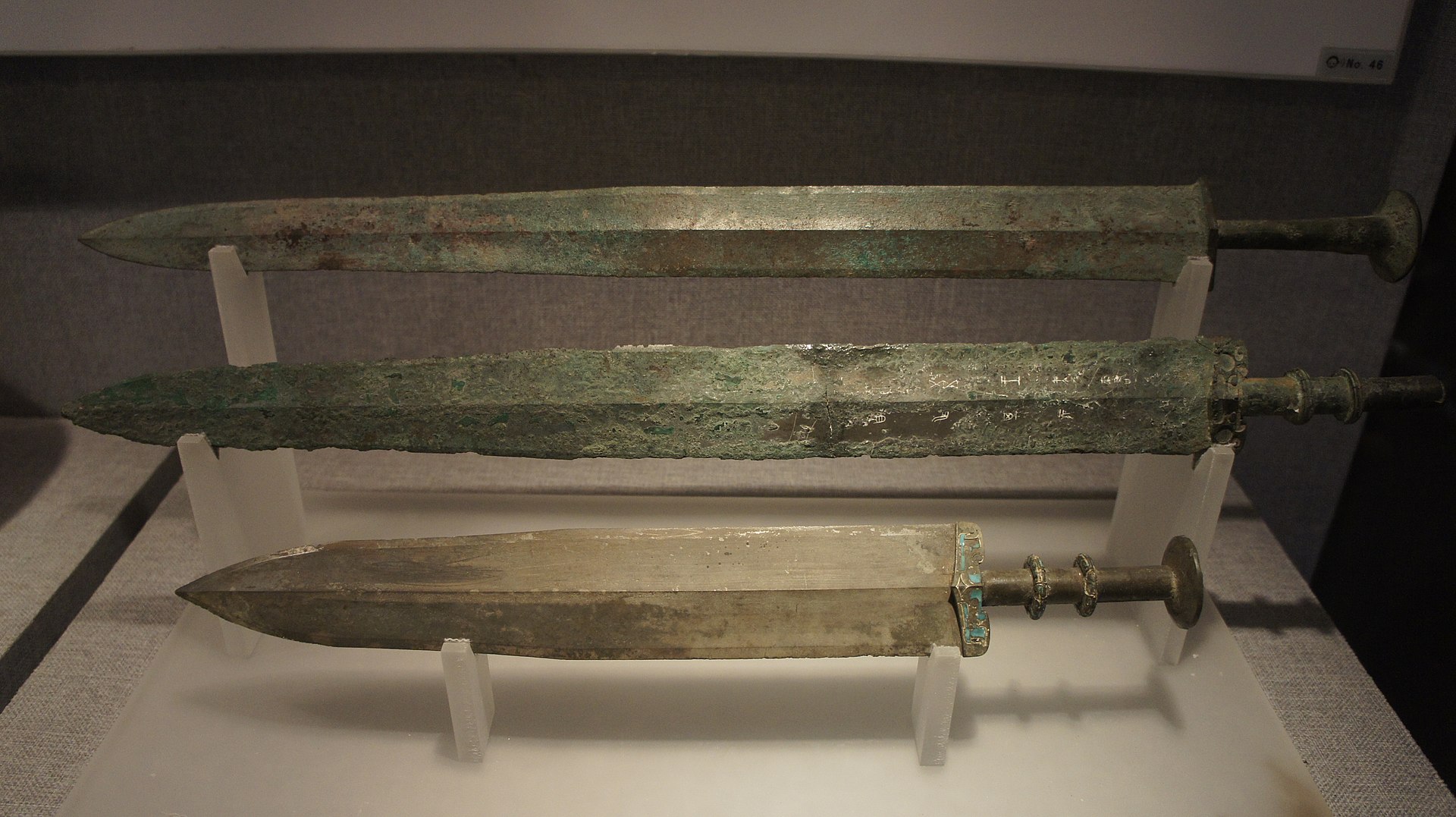
Warring States bronze jians.By Zcm11 - Own work, CC BY-SA 4.0, https://commons.wikimedia.org/w/index.php?curid=42812381
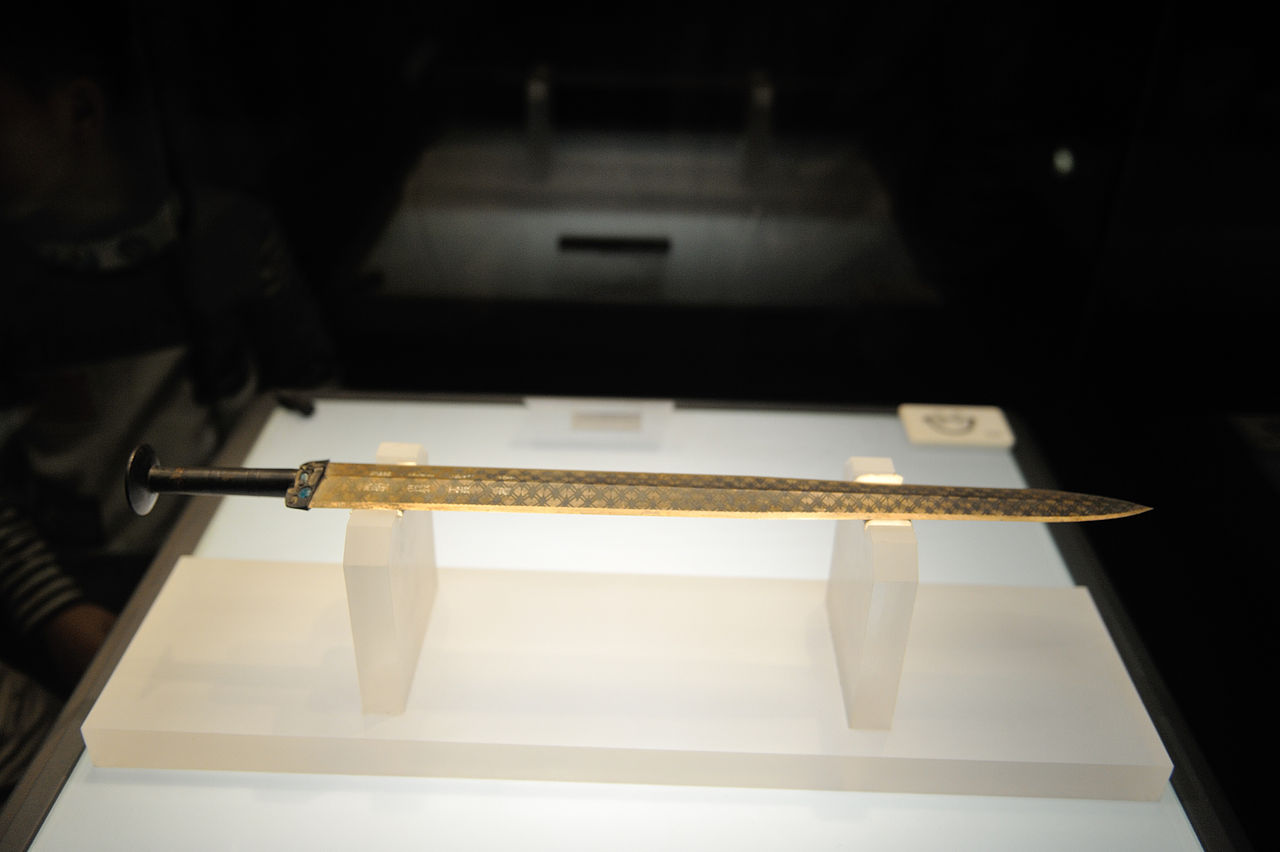
Sword of Goujian. By Zcm11 - Own work, CC BY-SA 4.0, https://commons.wikimedia.org/w/index.php?curid=42812381
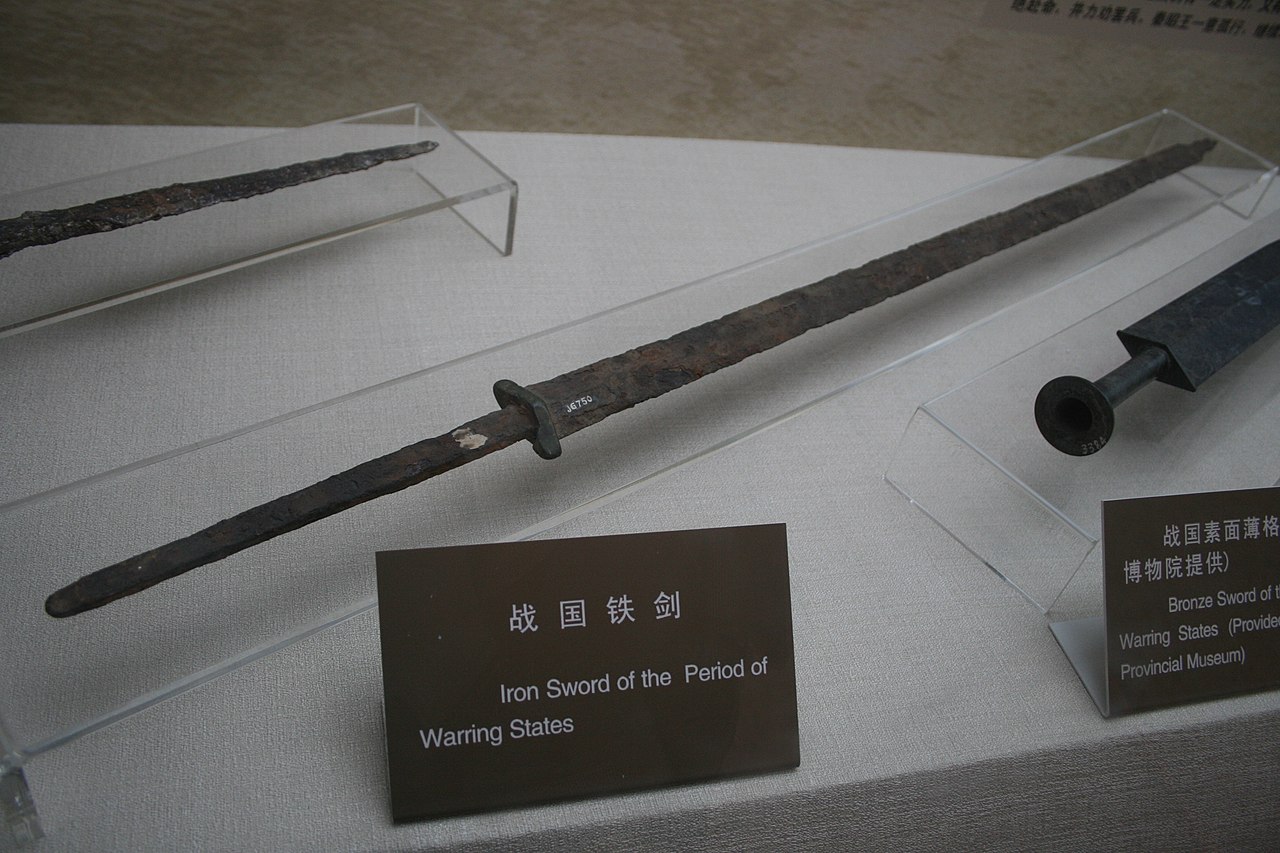
Warring States iron jian. By Flickr user Gary Todd - Military (People's Liberation Army) Museum; Now at https://www.flickr.com/photos/101561334@N08/9873599163, CC BY-SA 4.0, https://commons.wikimedia.org/w/index.php?curid=43951169
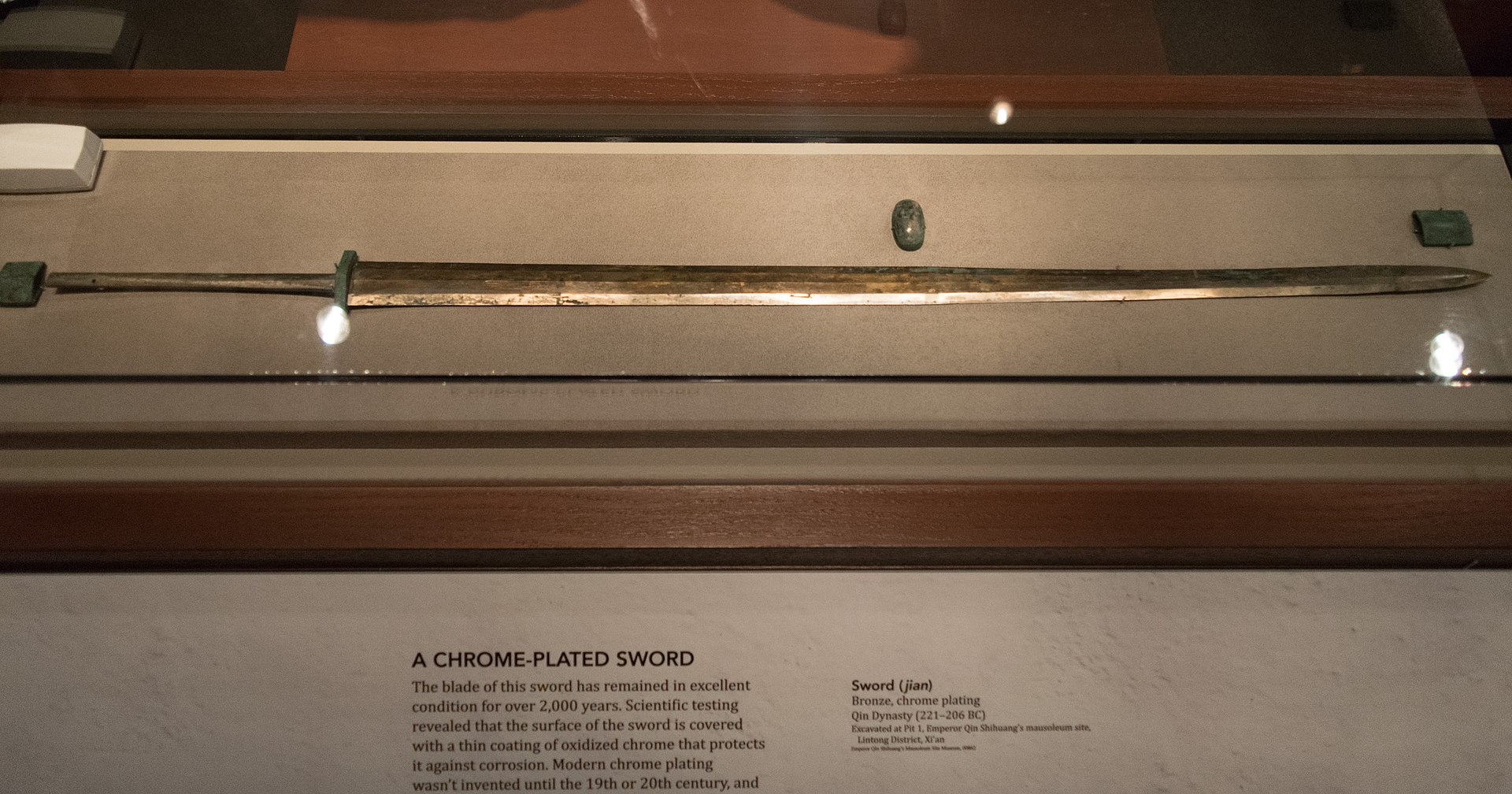
Qin dynasty jian. By Difference engine - Own work, CC BY-SA 4.0, https://commons.wikimedia.org/w/index.php?curid=50048181
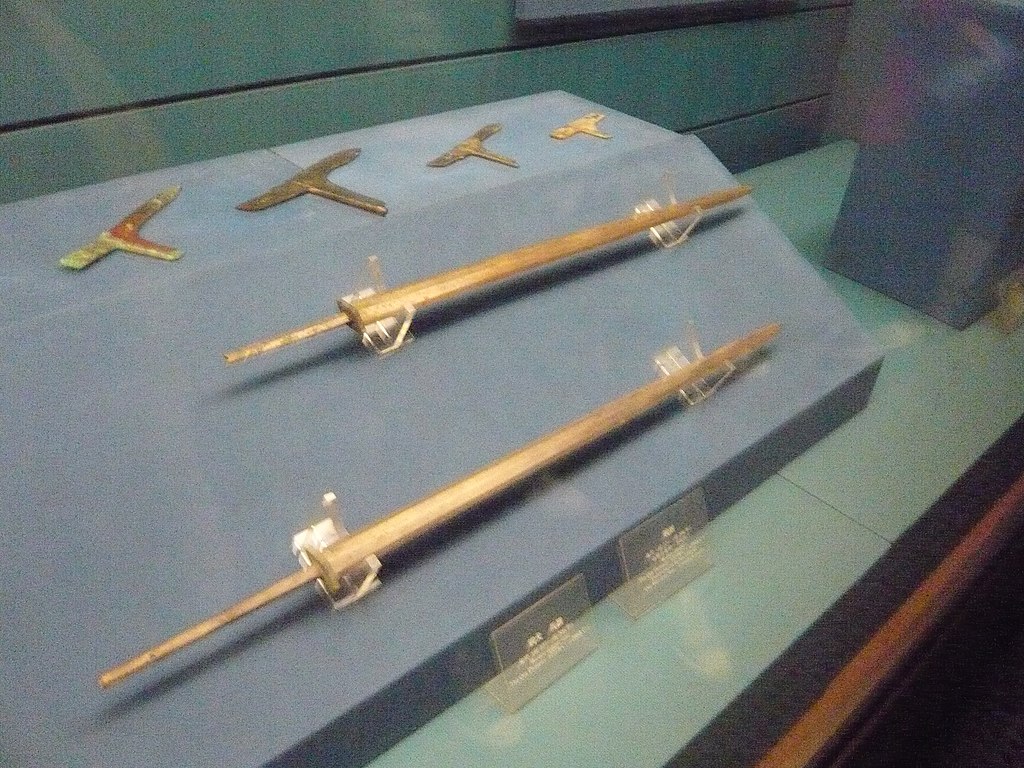
Qin bronze jians. By Difference engine - Own work, CC BY-SA 4.0, https://commons.wikimedia.org/w/index.php?curid=50048181
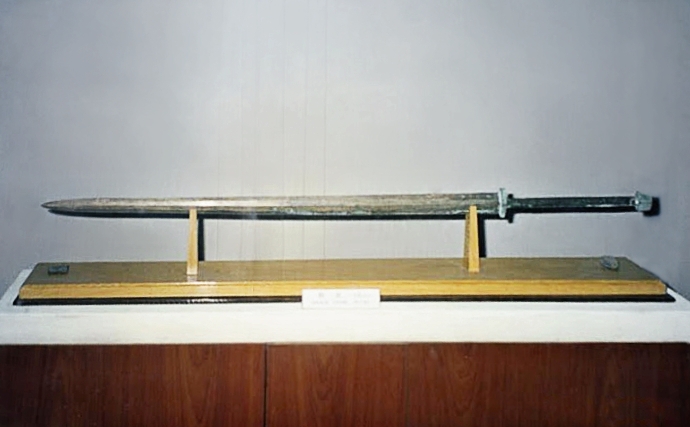
Qin jian. By Leon petrosyan - Own work, CC BY-SA 3.0, https://commons.wikimedia.org/w/index.php?curid=25414340
4. Han Dynasty (206 BC–220 AD)
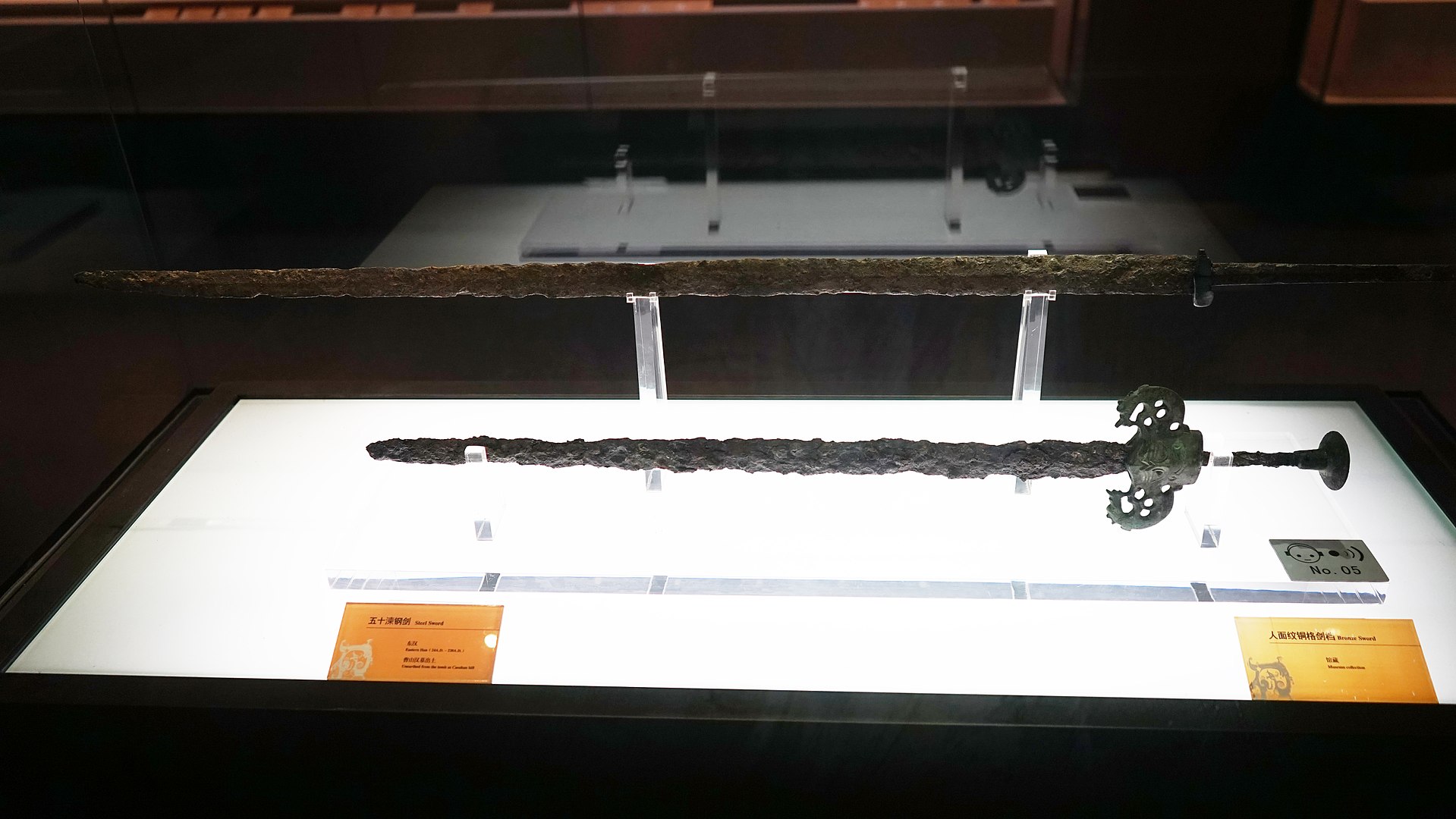
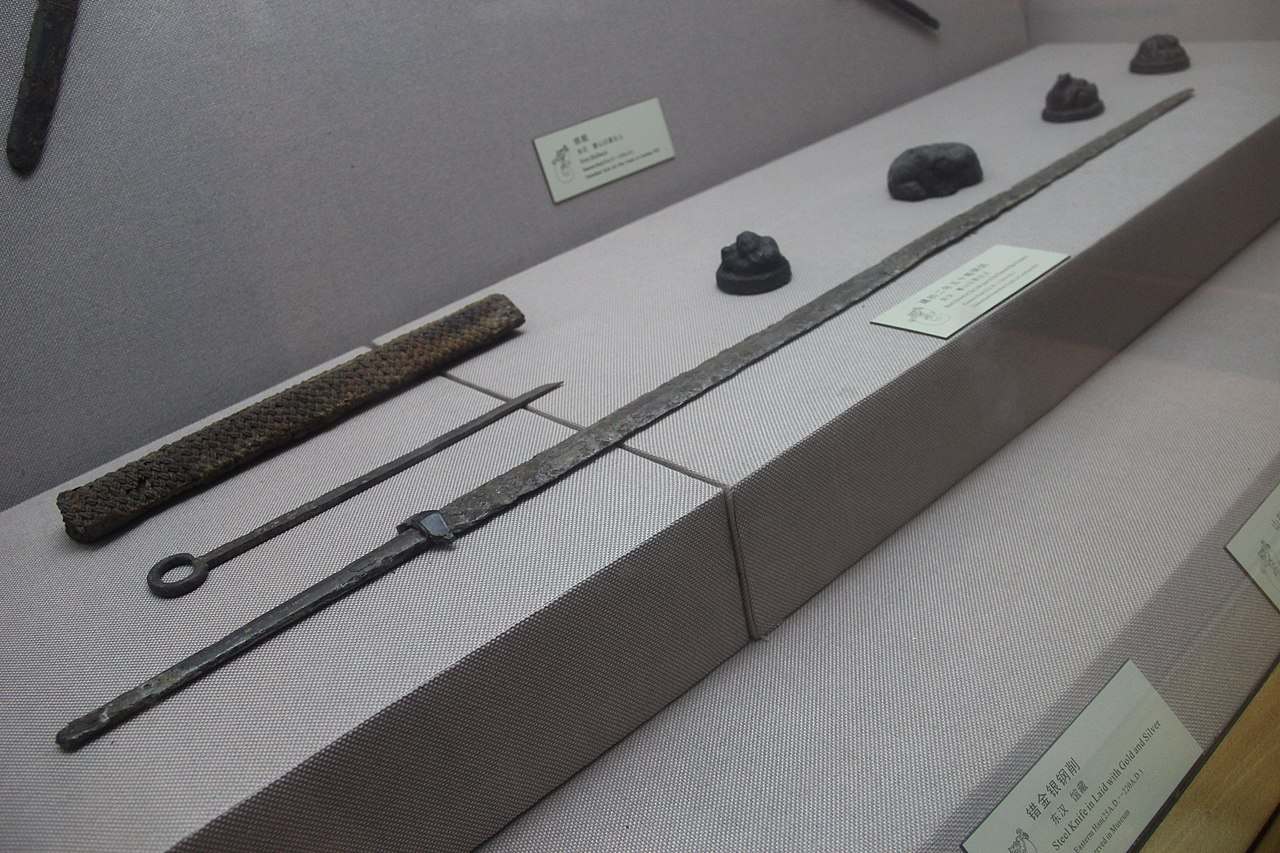
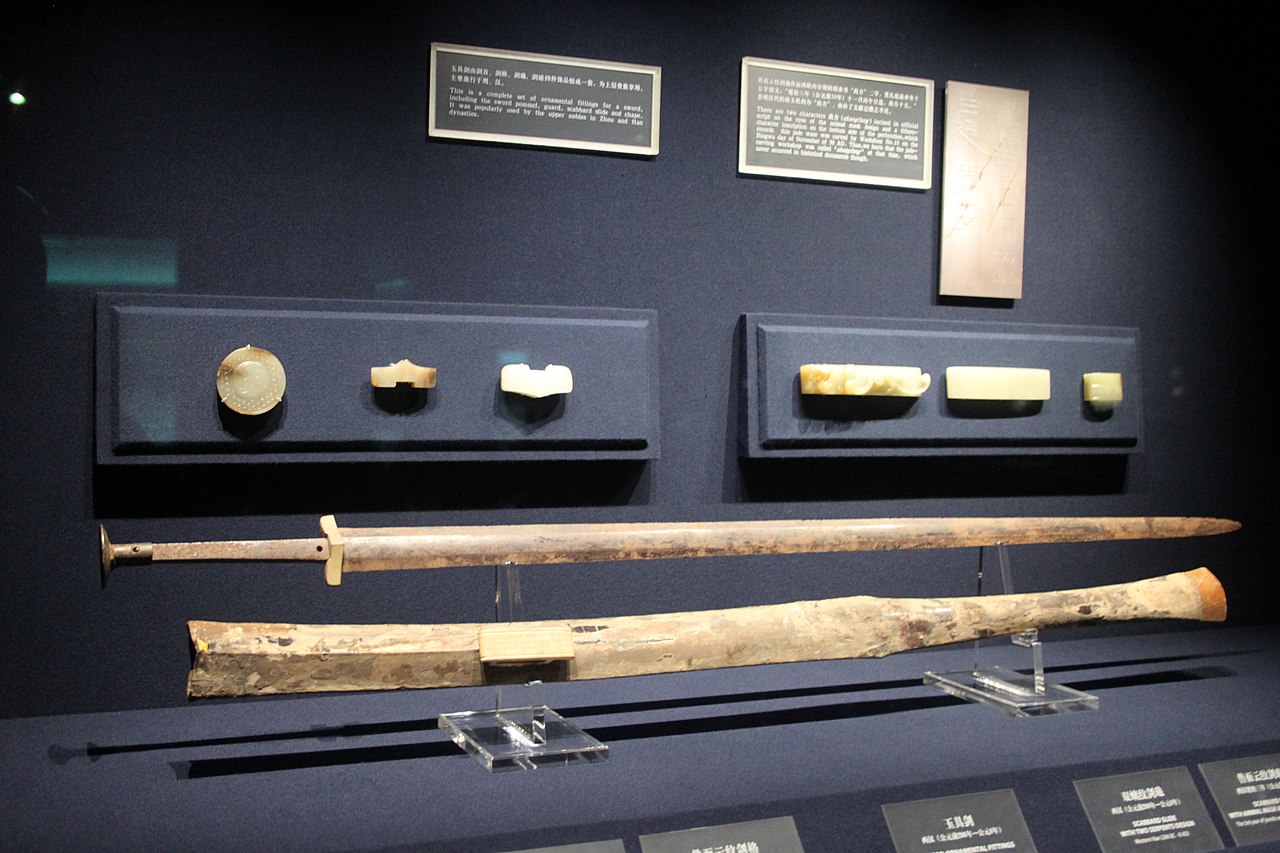
The jian was mentioned as one of the "Five Weapons" during the Han dynasty, the other four being dao, spear, halberd, and staff. Another version of the Five Weapons lists the bow and crossbow as one weapon, the jian and dao as one weapon, in addition to halberd, shield, and armour.[20]
The jian was a popular weapon during the Han era and there emerged a class of swordsmen who made their living through fencing. Sword fencing was also a popular pastime for aristocrats. A 37 chapter manual known as the Way of the Jian is known to have existed, but is no longer extant. South and central China were said to have produced the best swordsmen.[21] Han dynasty swords produced between the 1st and 2nd centuries AD have been found in Japan ; a ring-pommel dao with an inscription "thirty-fold refined" and a jian with the inscription "fifty-fold refined". A jian in Nara Prefecture was also found with an inscription saying it was produced in the Zhongping era (184-189 AD) and "hundredfold refined."[22]
There existed a weapon called the "Horse Beheading Jian", so called because it was supposedly able to cut off a horse's head.[23] However, another source says that it was an execution tool used on special occasions rather than a military weapon.[24]
Daos with ring pommels also became widespread as a cavalry weapon during the Han era. The dao had the advantage of being single edged, which meant the dull side could be thickened to strengthen the sword, making it less prone to breaking. When paired with a shield, the dao made for a practical replacement for the jian, hence it became the more popular choice as time went on. After the Han, sword dances using the dao rather than the jian are mentioned to have occurred. Archaeological samples range from 86 to 114 cm in length.[25]
An account of Duan Jiong's tactical formation in 167 AD specifies that he arranged "…three ranks of halberds (長鏃 changzu), swordsmen (利刃 liren) and spearmen (長矛 changmao), supported by crossbows (強弩 qiangnu), with light cavalry (輕騎 jingji) on each wing."[26]

Han jians. By [https://www.flickr.com/people/101561334@N08/ Flickr user> Gary Todd] - https://www.flickr.com/photos/101561334@N08/13970775348, CC0, https://commons.wikimedia.org/w/index.php?curid=68333009
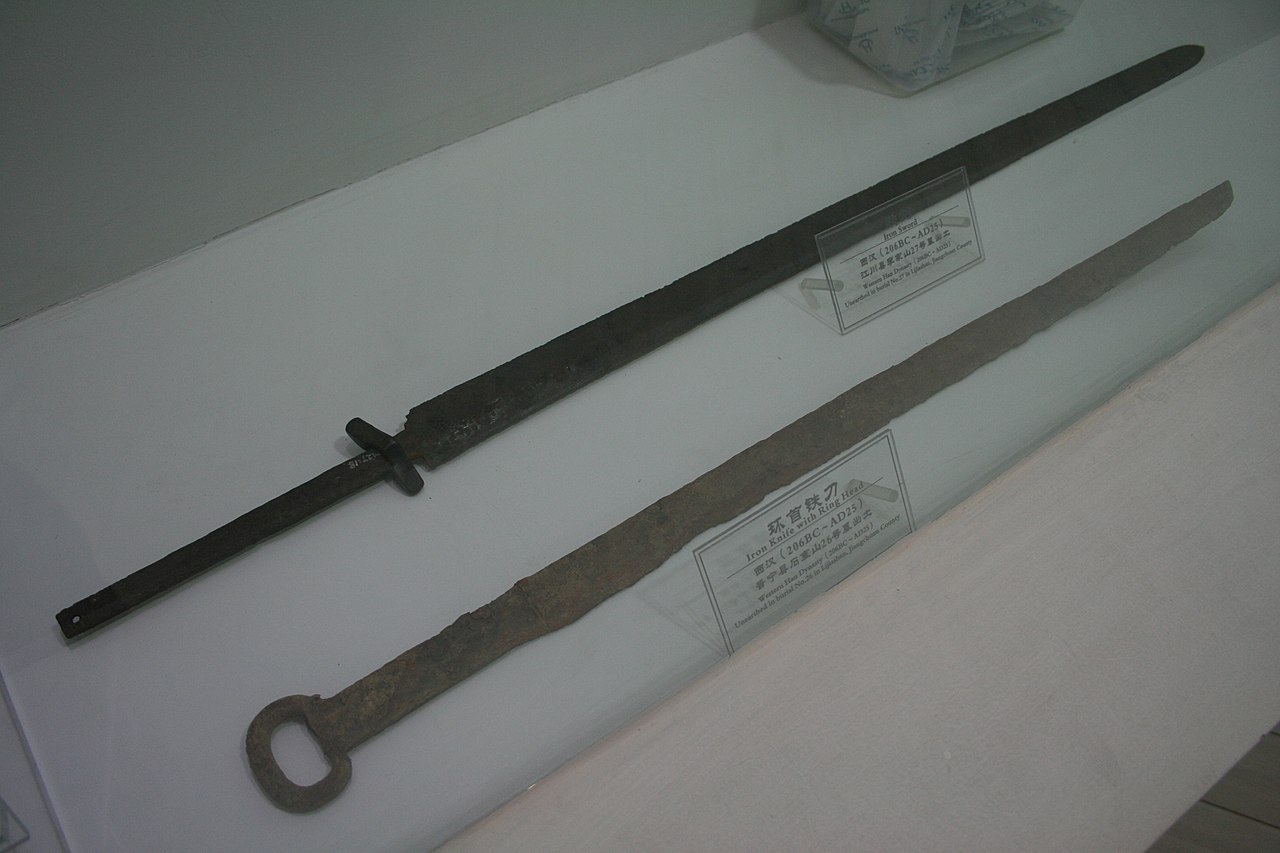
Han jian and dao. By [https://www.flickr.com/people/101561334@N08/ Flickr user> Gary Todd] - https://www.flickr.com/photos/101561334@N08/9965270865, CC0, https://commons.wikimedia.org/w/index.php?curid=67639825
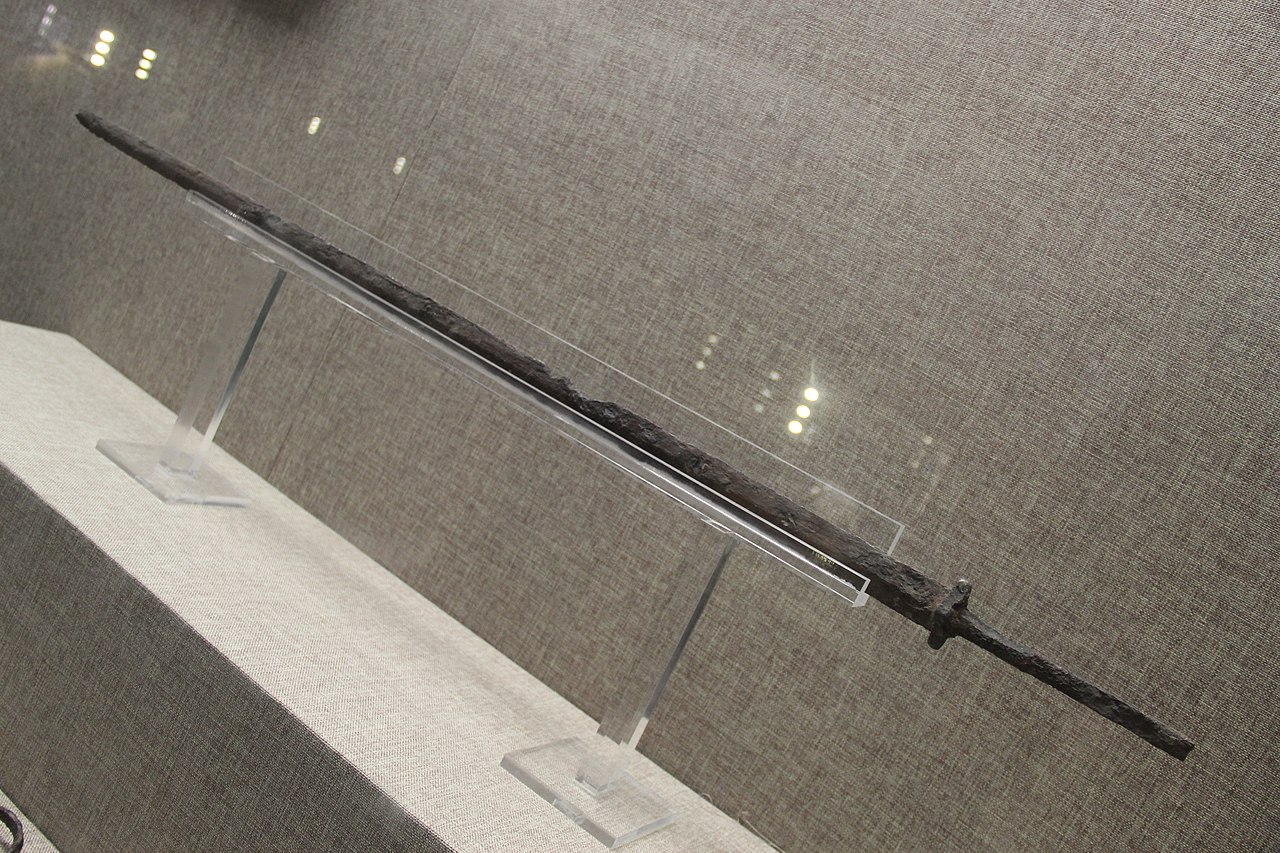
Western Han jian. By Gary Todd - https://www.flickr.com/photos/101561334@N08/10298835156/, CC0, https://commons.wikimedia.org/w/index.php?curid=98299247
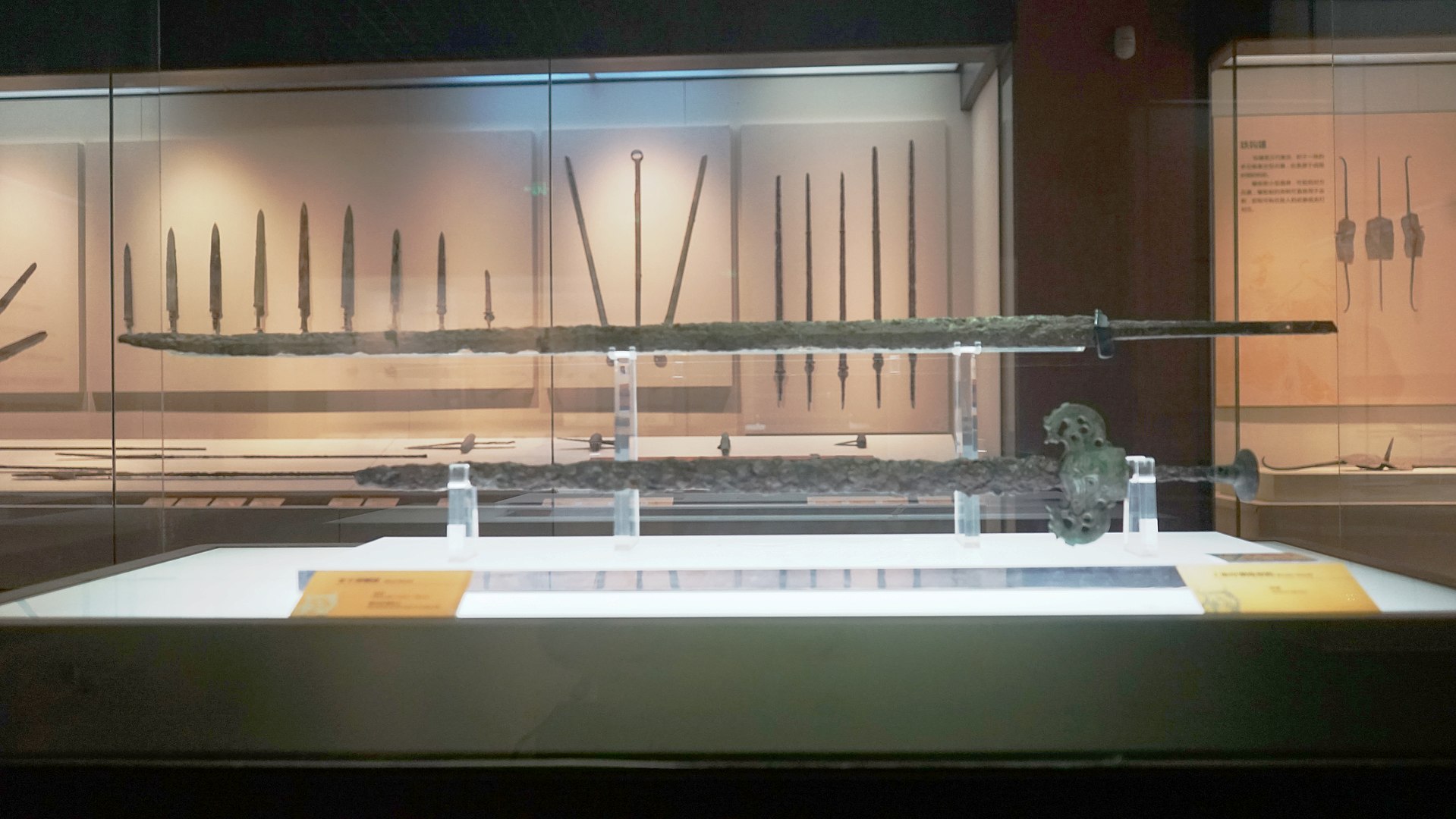
Han jian with elaborate sword guard. By 白色瑰宝 - Own work, CC BY-SA 4.0, https://commons.wikimedia.org/w/index.php?curid=64604972
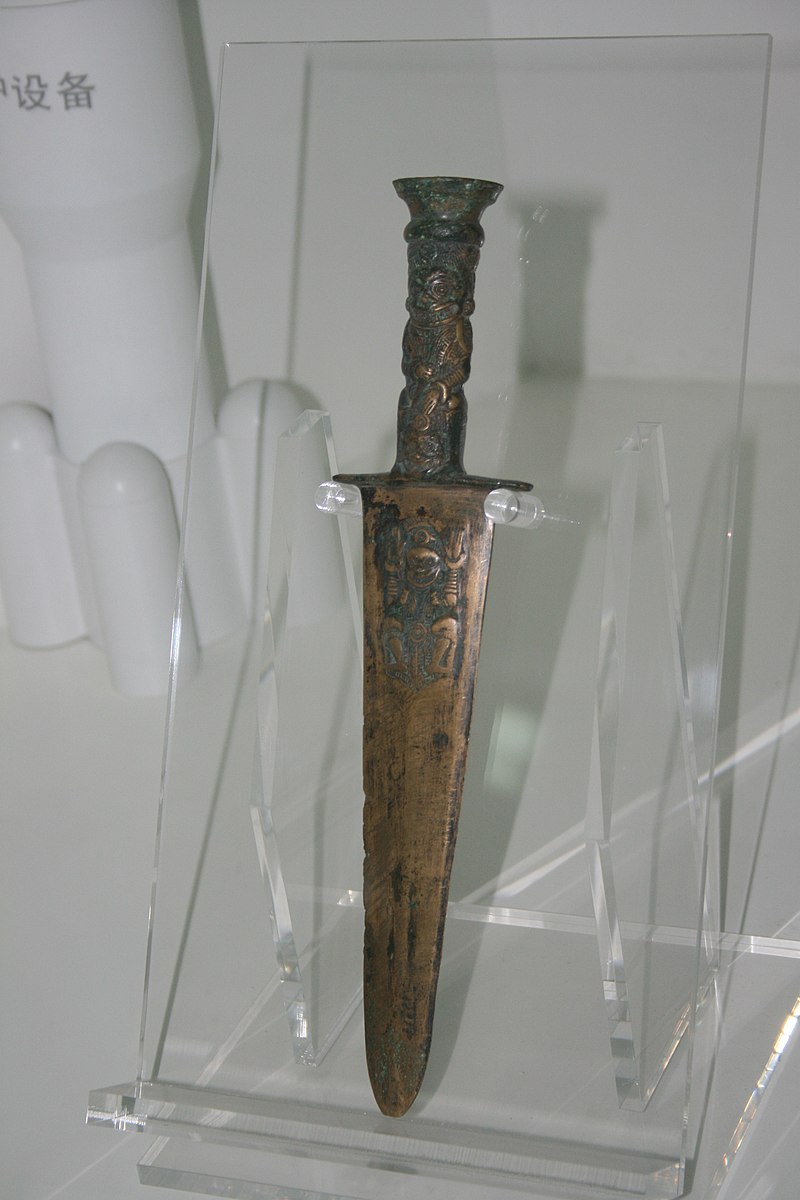
Dian Kingdom bronze dagger. By Gary Todd from Xinzheng, China - Warring States Dian Bronze Sword, CC0, https://commons.wikimedia.org/w/index.php?curid=101207422
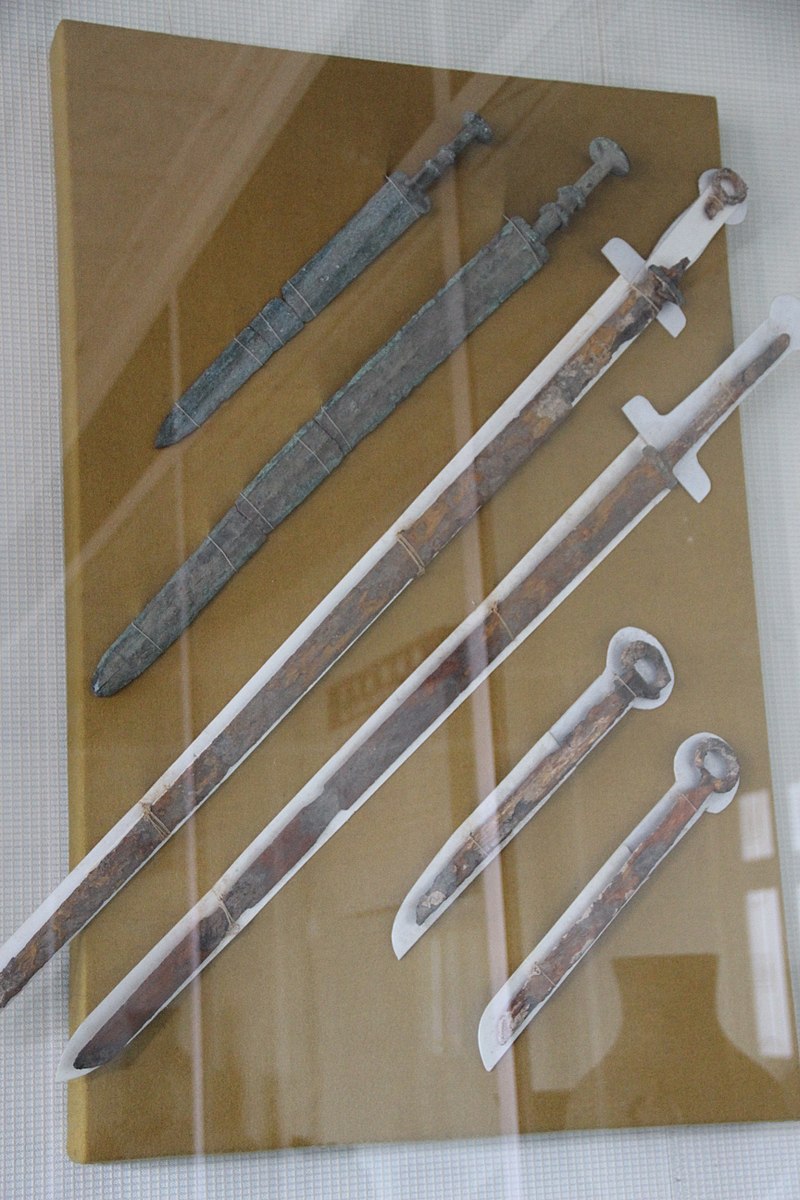
Han knives and jians. By Flickr user Gary Todd - https://www.flickr.com/photos/101561334@N08/9905717296, CC0, https://commons.wikimedia.org/w/index.php?curid=67546613
5. Three Kingdoms (184/220–280)
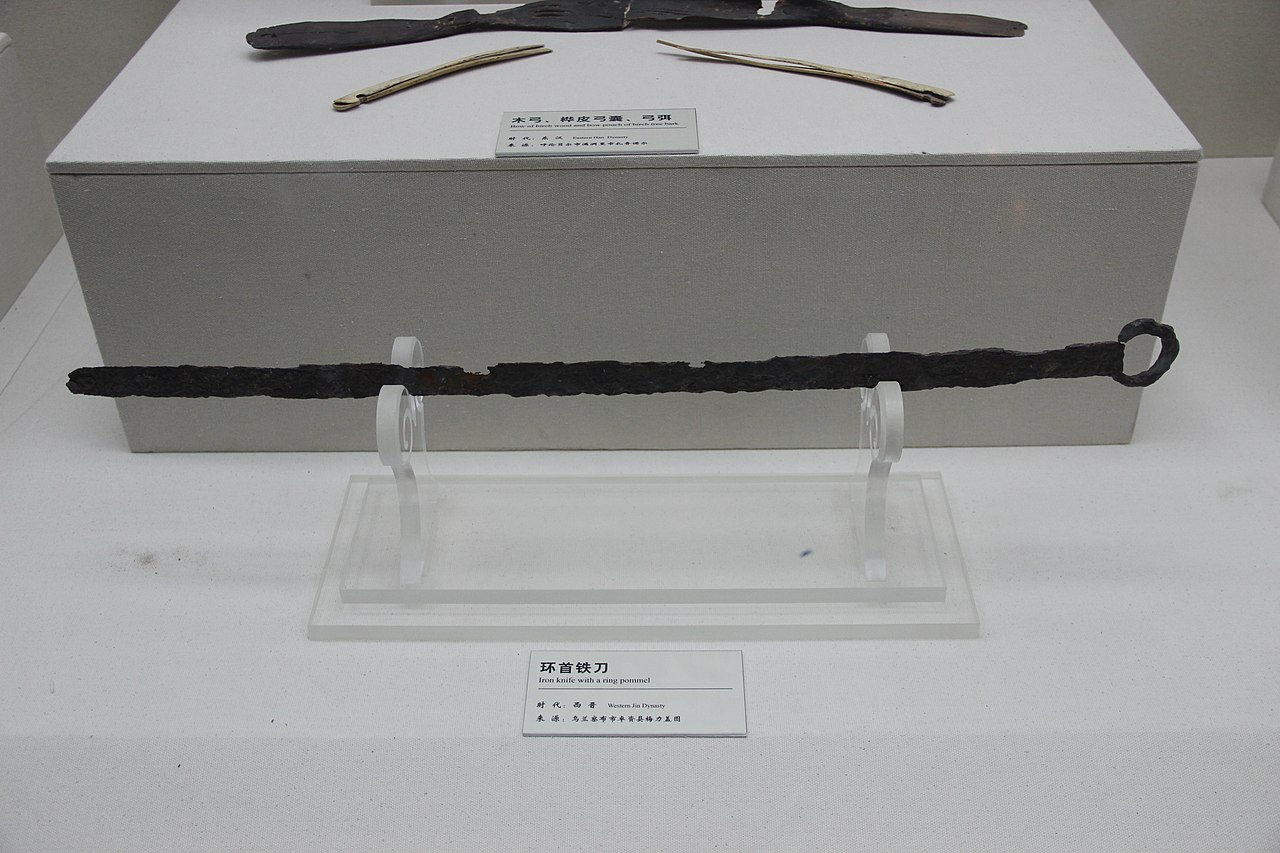 Jin dynasty (266–420) dao. By [https://www.flickr.com/people/101561334@N08/ Flickr user> Gary Todd] - https://www.flickr.com/photos/101561334@N08/19805742776, CC0, https://commons.wikimedia.org/w/index.php?curid=68333124
Jin dynasty (266–420) dao. By [https://www.flickr.com/people/101561334@N08/ Flickr user> Gary Todd] - https://www.flickr.com/photos/101561334@N08/19805742776, CC0, https://commons.wikimedia.org/w/index.php?curid=68333124Swords of idiosyncratic sizes are mentioned. One individual named Chen apparently wielded a great sword over two meters in length.[27]
Sun Quan's wife had over a hundred female attendants armed with daos.[28]
By the end of the Three Kingdoms the dao had completely overtaken the jian as the primary close combat weapon.[29] The lighter and less durable double edged jian entered the domain of court dancers, officials, and expert warriors.[30]
6. Northern and Southern Dynasties (420–589)

In the 6th century, Qimu Huaiwen introduced to Northern Qi the process of 'co-fusion' steelmaking, which used metals of different carbon contents to create steel. Apparently, daos made using this method were capable of penetrating 30 armour lamellae. It's not clear if the armour was of iron or leather.
7. Tang Dynasty (618–907)

The dao was separated into four categories during the Tang dynasty. These were the Ceremonial Dao, Defense Dao, Cross Dao, and Divided Dao. The Ceremonial Dao was a court item usually decorated with gold and silver. It was also known as the "Imperial Sword". The Defense Dao does not have any specifications but its name is self-explanatory. The Cross Dao was a waist weapon worn on the belt, hence its older name, the Belt Dao. It was often carried as a sidearm by crossbowmen.[31] The Divided Dao, also called a Long Dao (long saber), was a cross between a polearm and a saber. It consisted of a 91 cm blade fixed to a long 120 cm handle ending in an iron butt point, although exceptionally large weapons reaching 3 meters in length and weighing 10.2 kg have been mentioned.[32] Divided daos were wielded by elite Tang vanguard forces and used to spearhead attacks.[23]
8. Song Dynasty (960–1279)
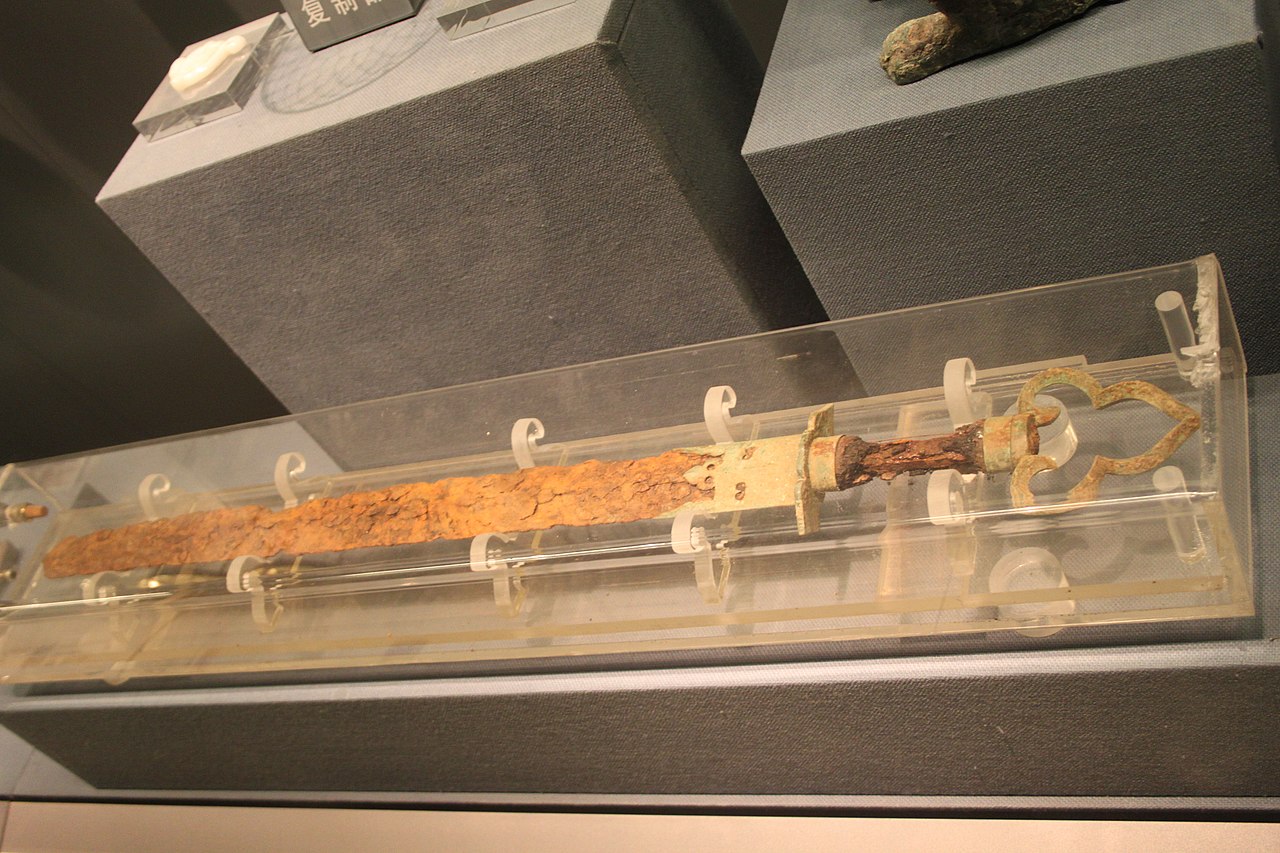
Some warriors and bandits duel wielded daos to break deadlocks in confined terrain during the late Song dynasty.[33]
According to the Xu Zizhi Tongjian Changbian, written in 1183, the "Horse Beheading Dao" (zhanmadao) was a two handed saber with a 93.6 cm blade, 31.2 cm hilt, and ring pommel.[34]
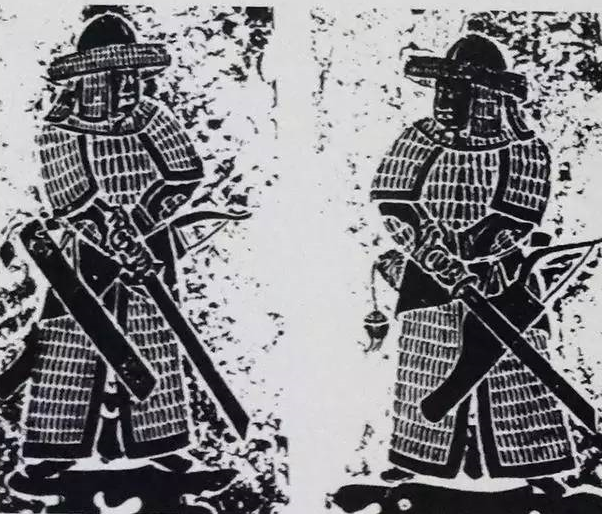
Song soldiers carrying daos. By Tomb in Pengshan, Sichuan - 宋朝历史书, Public Domain, https://commons.wikimedia.org/w/index.php?curid=74714352
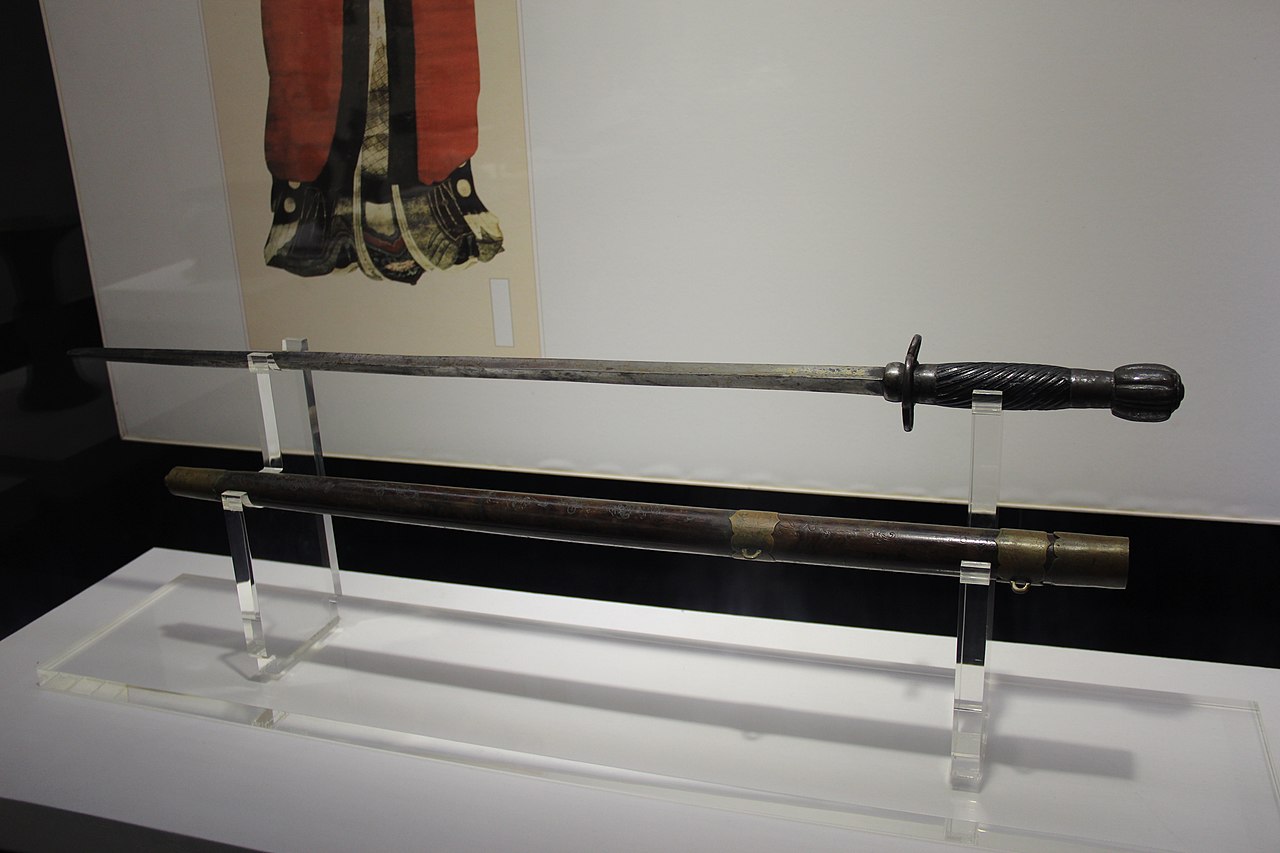
Truncheon, Song dynasty. By Gary Todd from Xinzheng, China - Sword/Truncheon, Northern Song, Heirloom, CC0, https://commons.wikimedia.org/w/index.php?curid=102834020
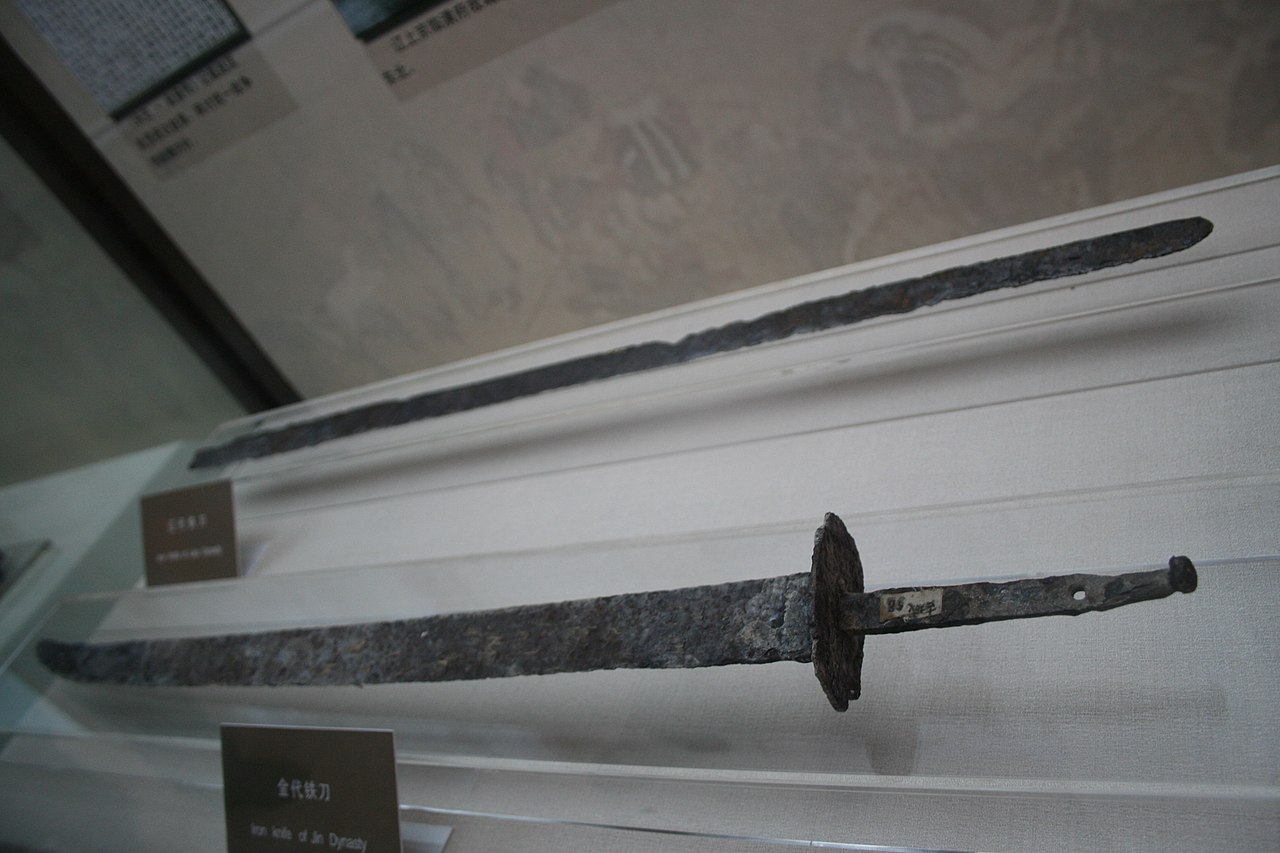
Liao and Jin swords. By Flickr user Gary Todd - https://www.flickr.com/photos/101561334@N08/9872928175, CC0, https://commons.wikimedia.org/w/index.php?curid=67542963
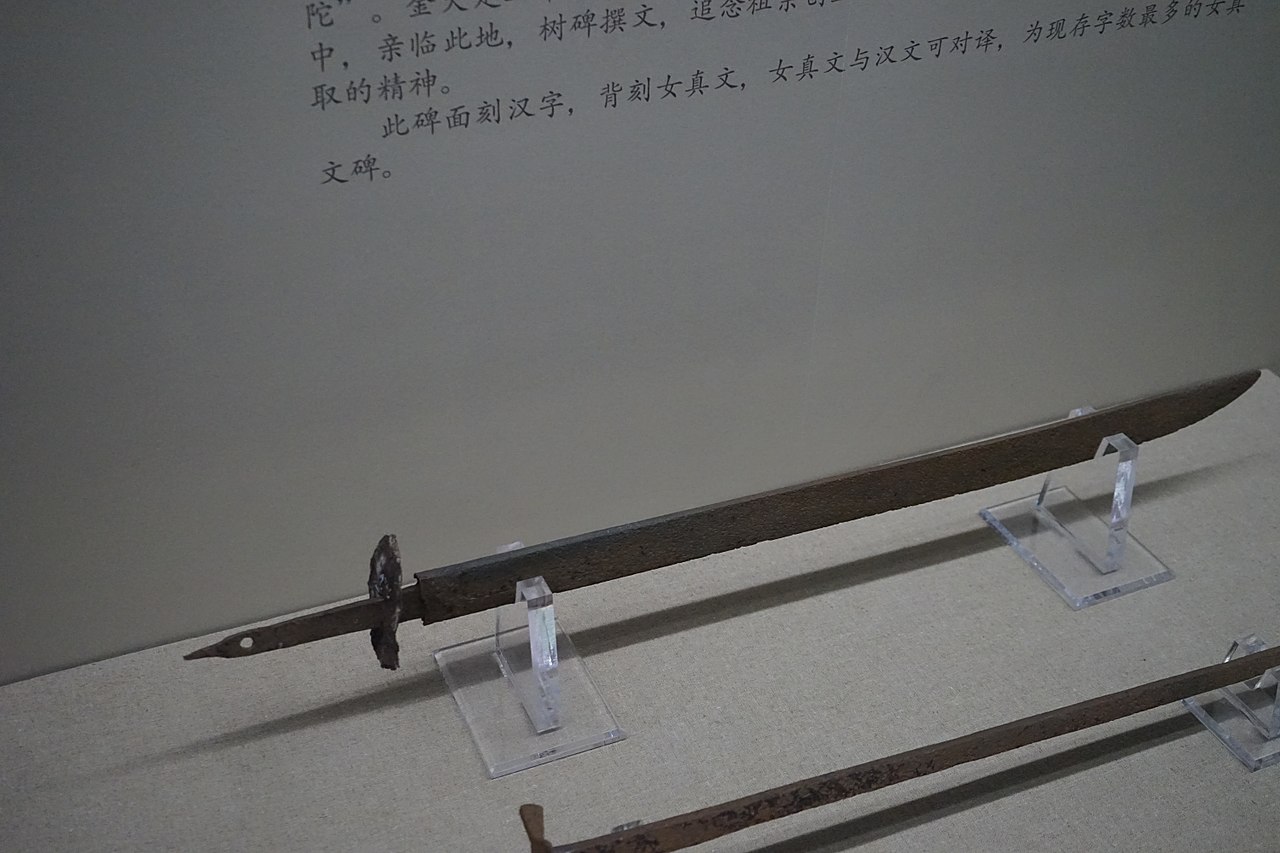
Jin dao sabre. By Huanokinhejo - Own work, CC BY-SA 4.0, https://commons.wikimedia.org/w/index.php?curid=63822894

Yuan dao. By Gary Todd from Xinzheng, China - Yuan Iron Sword, CC0, https://commons.wikimedia.org/w/index.php?curid=102666819
9. Yuan Dynasty (1279–1368)
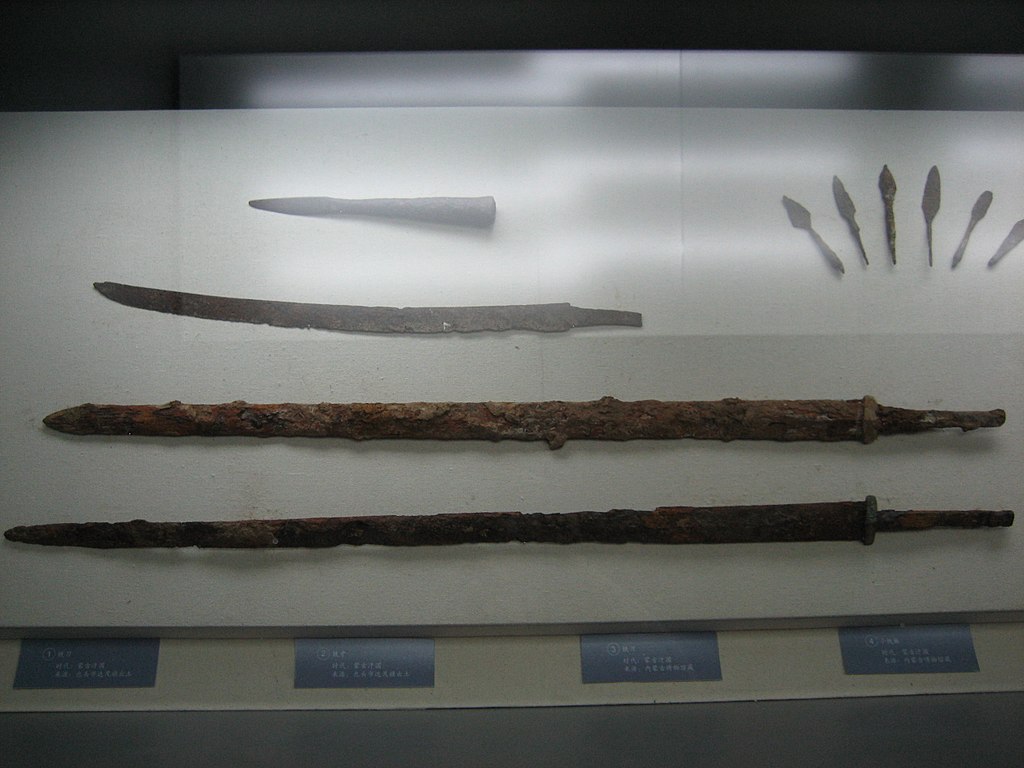 Chinese style jian from the Mongol Empire era. By Gary Todd from Xinzheng, China - Yuan Iron Sword, CC0, https://commons.wikimedia.org/w/index.php?curid=102666819
Chinese style jian from the Mongol Empire era. By Gary Todd from Xinzheng, China - Yuan Iron Sword, CC0, https://commons.wikimedia.org/w/index.php?curid=102666819Under the Yuan dynasty, the jian experienced a resurgence and was used more often.[35]
10. Ming Dynasty (1368–1644)
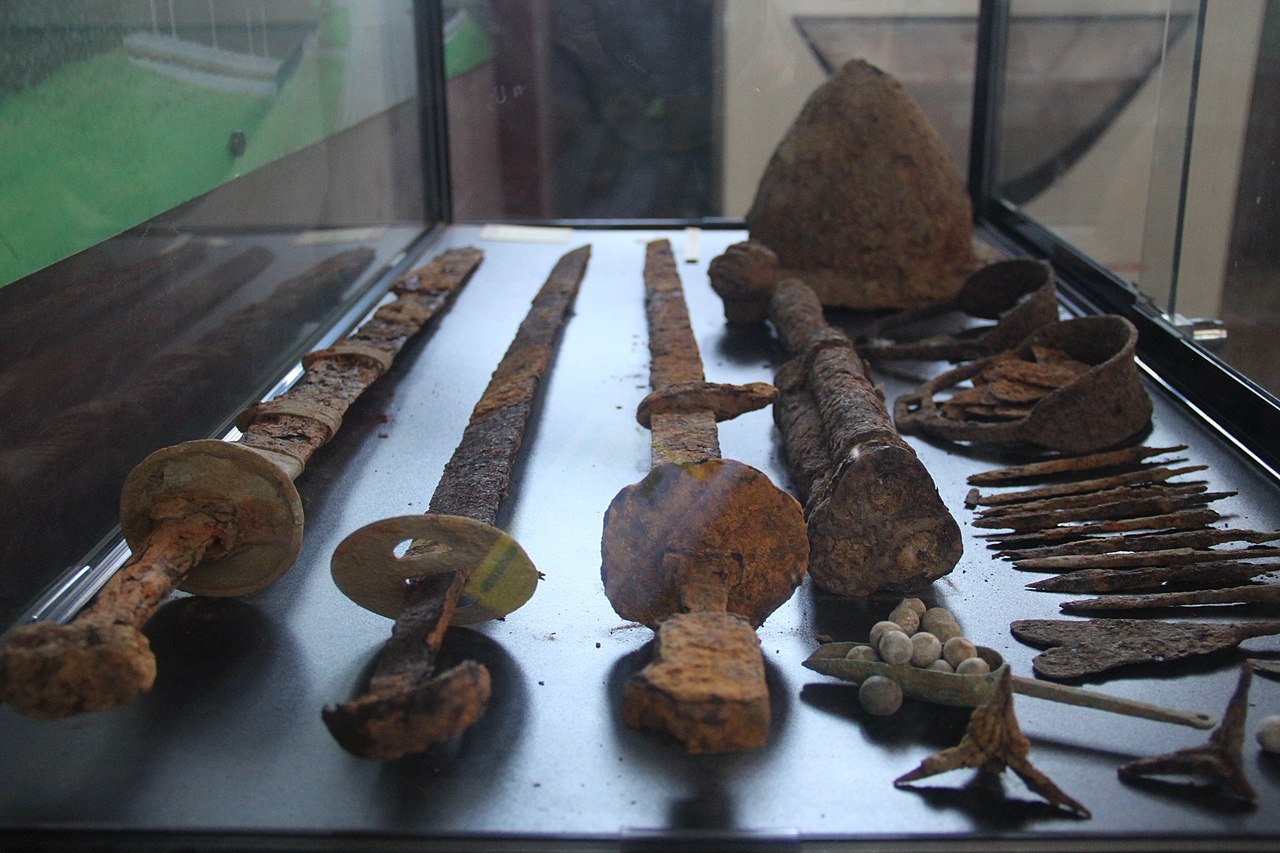 Jurchen swords. By Gary Lee Todd, Ph.D. - https://www.flickr.com/photos/101561334@N08/13968819457/, CC0, https://commons.wikimedia.org/w/index.php?curid=102349396
Jurchen swords. By Gary Lee Todd, Ph.D. - https://www.flickr.com/photos/101561334@N08/13968819457/, CC0, https://commons.wikimedia.org/w/index.php?curid=102349396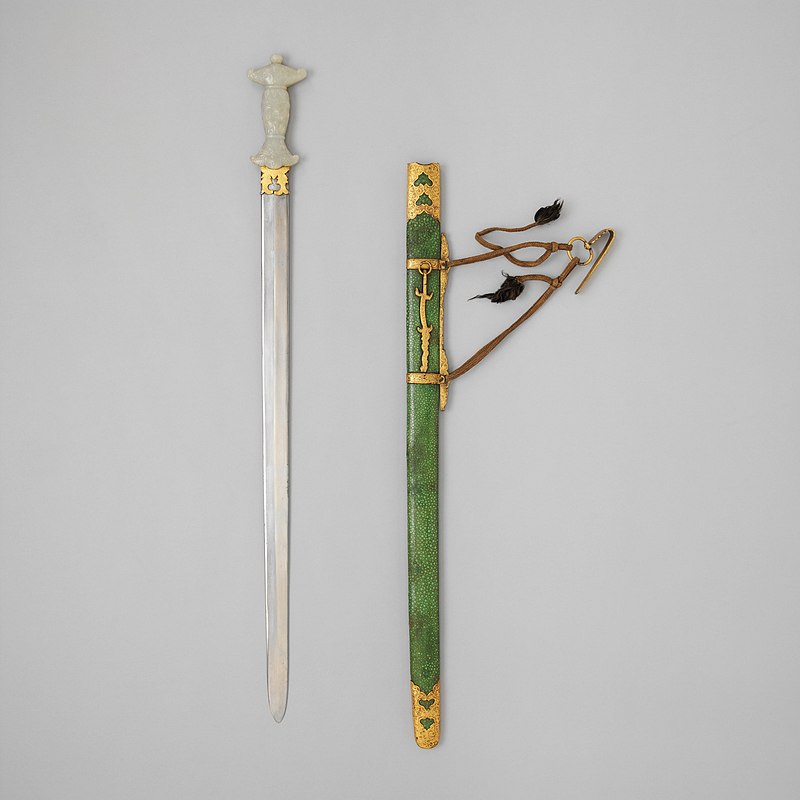 Qing dynasty jian with jade hilt. By This file was donated to Wikimedia Commons as part of a project by the Metropolitan Museum of Art. See the Image and Data Resources Open Access Policy, CC0, https://commons.wikimedia.org/w/index.php?curid=65049291
Qing dynasty jian with jade hilt. By This file was donated to Wikimedia Commons as part of a project by the Metropolitan Museum of Art. See the Image and Data Resources Open Access Policy, CC0, https://commons.wikimedia.org/w/index.php?curid=65049291The dao continued to fill the role of the basic close combat weapon.[36] The jian fell out of favor again in the Ming era but saw limited use by a small number of arms specialists. It was otherwise known for its qualities as a marker of scholarly refinement.[35]
The "Horse Beheading Dao" was described in Ming sources as a 96 cm blade attached to a 128 cm shaft, essentially a glaive. It's speculated that the Swede Frederick Coyett was talking about this weapon when he described Zheng Chenggong's troops wielding "with both hands a formidable battle-sword fixed to a stick half the length of a man".[37]
Qi Jiguang deployed his soldiers in a 12-man 'mandarin duck' formation, which consisted of four pikemen, two men carrying daos with a great and small shield, two 'wolf brush' wielders, a rearguard officer, and a porter.[38]

Ming whip, truncheon, and dao. By Flickr user Gary Todd - https://www.flickr.com/photos/101561334@N08/9883019554, CC0, https://commons.wikimedia.org/w/index.php?curid=67534629
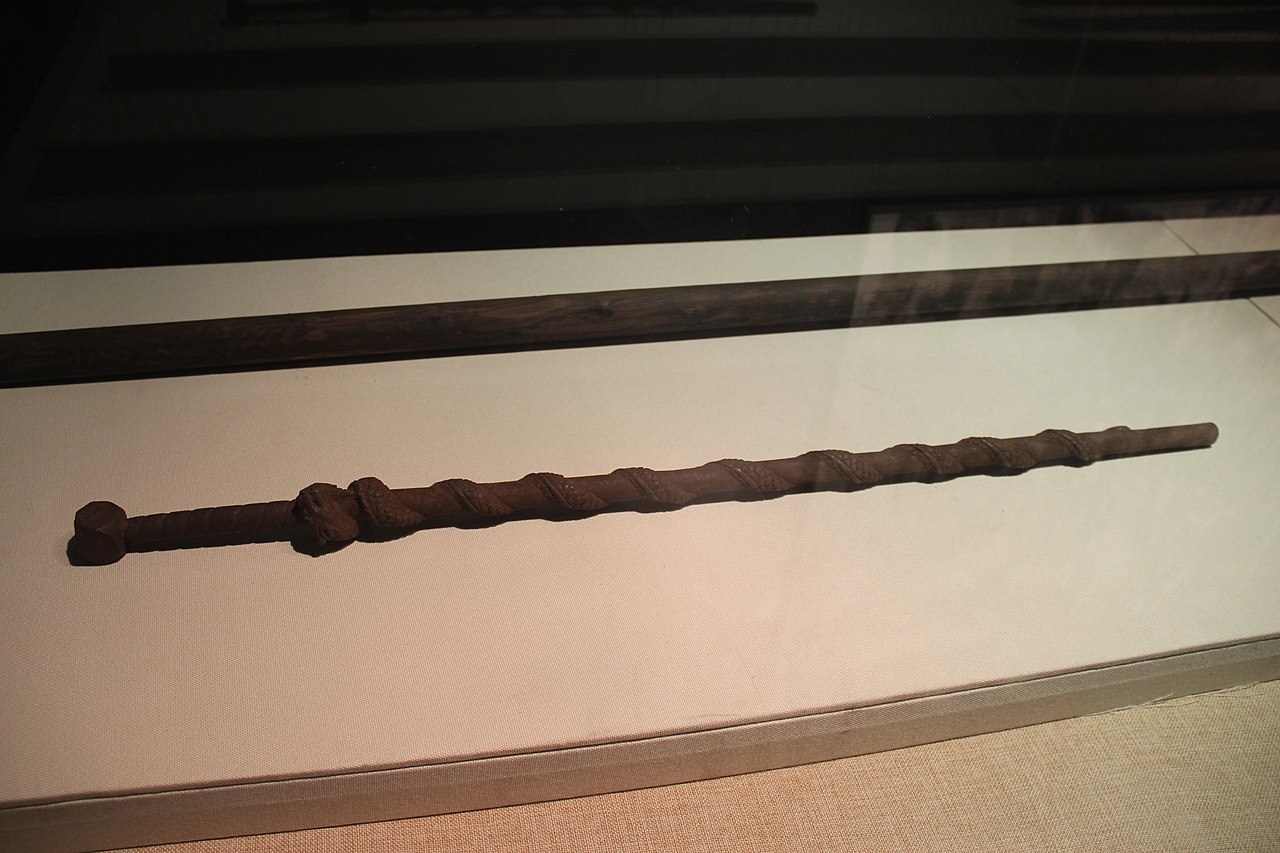
Ming truncheon. By Flickr user Gary Todd - https://www.flickr.com/photos/101561334@N08/9883019554, CC0, https://commons.wikimedia.org/w/index.php?curid=67534629

Ming dao. By [https://www.flickr.com/people/101561334@N08/ Flickr user> Gary Todd] - https://www.flickr.com/photos/101561334@N08/19654750109, CC0, https://commons.wikimedia.org/w/index.php?curid=68333122
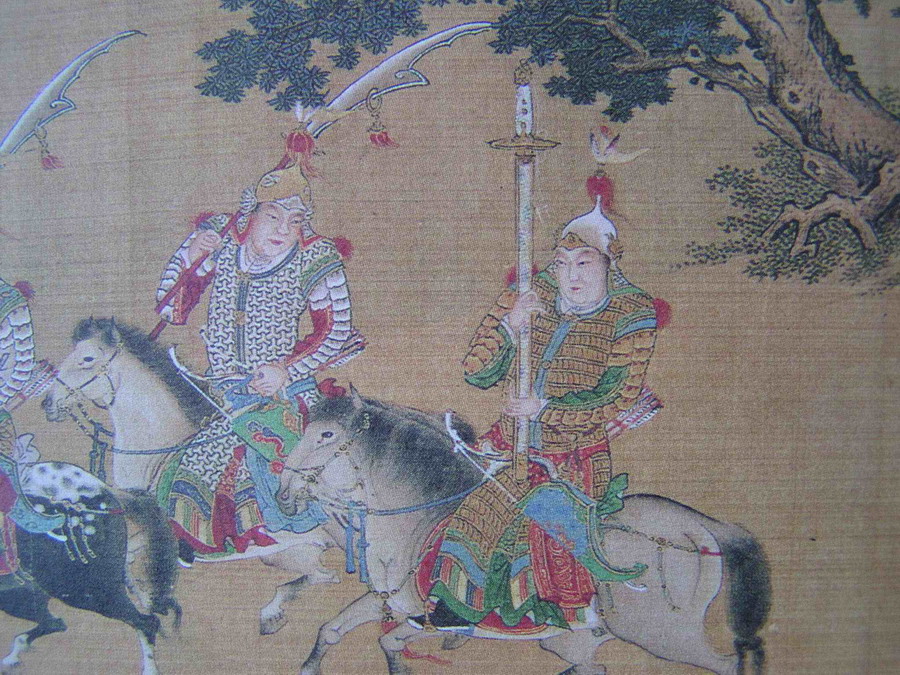
Ming soldiers carrying a dao and jian. By Unknown author - Departure Herald, Public Domain, https://commons.wikimedia.org/w/index.php?curid=37850472

Ming soldier carrying a jian. By Anonymous - Unknown source, Public Domain, https://commons.wikimedia.org/w/index.php?curid=67512536
11. Ming-Qing Sword Types
| Image | Name | Era | Description |
|---|---|---|---|
 |
Butterfly sword | Sometimes called butterfly knives in English. It was originally from southern China, though it has seen use in the north. It is usually wielded in pairs, and has short dao (single-edged blade), with a length is approximately that of the forearm. This allows for easy concealment within the sleeves or inside boots, and for greater manoeuvrability to spin and rotate in close-quarters fighting. | |
| Changdao | Ming dynasty | A type of anti-cavalry sword used in China during the Ming dynasty. Sometimes called miao dao (a similar but more recent weapon), the blade greatly resembles a Japanese ōdachi in form. | |
 |
Dadao | Also known as the Chinese great sword. Based on agricultural knives, dadao have broad blades generally between two and three feet long, long hilts meant for "hand and a half" or two-handed use, and generally a weight-forward balance. | |
 |
Hook sword | The hook sword is an exotic Chinese weapon traditionally associated with Northern styles of Chinese martial arts, but now often practised by Southern styles as well. | |
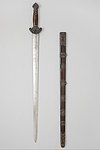 |
Jian | The jian is a double-edged straight sword used during the last 2,500 years in China. The first Chinese sources that mention the jian date to the 7th century BC during the Spring and Autumn period;[39] one of the earliest specimens being the Sword of Goujian.
Historical one-handed versions have blades varying from 45 to 80 centimeters (17.7 to 31.5 inches) in length. The weight of an average sword of 70-centimeter (28-inch) blade-length would be in a range of approximately 700 to 900 grams (1.5 to 2 pounds). There are also larger two-handed versions used for training by many styles of Chinese martial arts. In Chinese folklore, it is known as the "Gentleman of Weapons" and is considered one of the four major weapons, along with the gun (staff), qiang (spear), and the dao. |
|
 |
Liuyedao | The liuye dao, or "willow leaf saber", is a type of dao that was commonly used as a military sidearm for both cavalry and infantry during the Ming and Qing dynasties. This weapon features a moderate curve along the length of the blade. This reduces thrusting ability (though it is still fairly effective at same) while increasing the power of cuts and slashes. | |
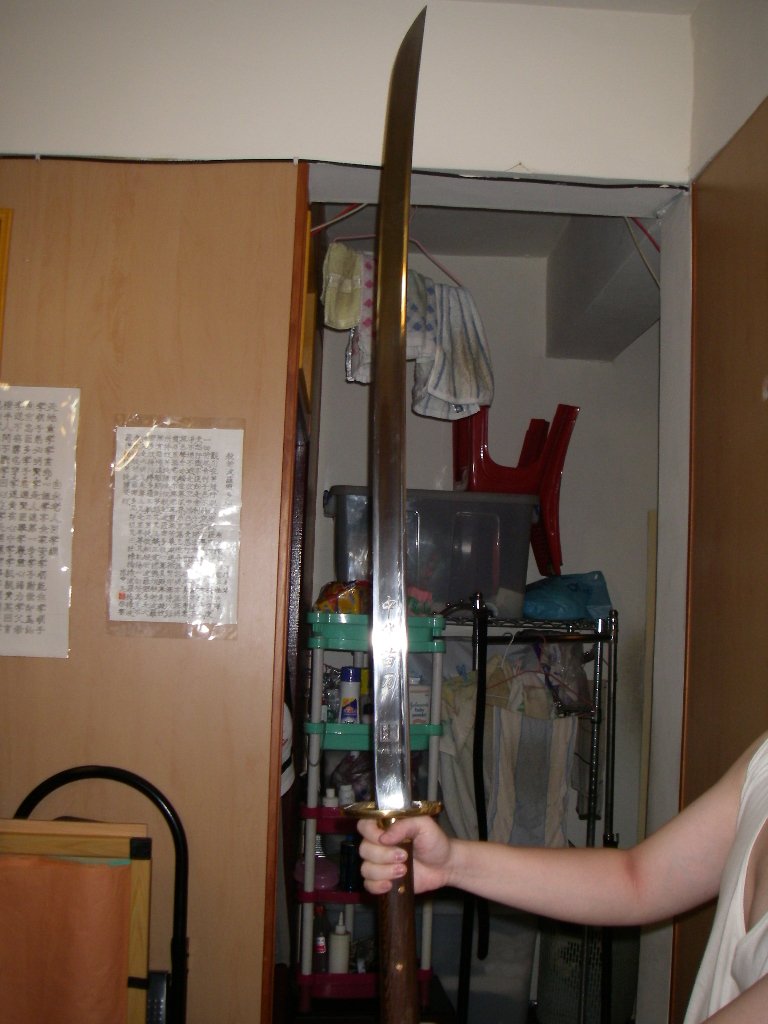 |
Miaodao | Republican era | A Chinese two-handed dao or saber of the Republican era, with a narrow blade of up to 1.2 meters or more and a long hilt. The name means "sprout saber", presumably referring to a likeness between the weapon and a newly sprouted plant. While the miaodao is a recent weapon, the name has come to be applied to a variety of earlier Chinese long sabers, such as the zhanmadao and changdao. Along with the dadao, miaodao were used by some Chinese troops during the Second Sino-Japanese War. |
| Nandao | Nandao is a kind of sword that is nowadays used mostly in contemporary wushu exercises and forms. It is the southern variation of the "northern broadsword", or Beidao. Its blade bears some resemblance to the butterfly sword, also a southern Chinese single-bladed weapon; the main difference is the size, and the fact that the butterfly swords are always used in pairs | ||
 |
Niuweidao | Late Qing dynasty | A type of Chinese saber (dao) of the late Qing dynasty. It was primarily a civilian weapon, as imperial troops were never issued it. |
| Piandao | Late Ming dynasty | A type of Chinese sabre (dao) used during the late Ming dynasty. A deeply curved dao meant for slashing and draw-cutting, it bore a strong resemblance to the shamshir and scimitar. A fairly uncommon weapon, it was generally used by skirmishers in conjunction with a shield. | |
| Wodao | Ming dynasty | A Chinese sword from the Ming dynasty. Apparently influenced by Japanese sword design, it bears a strong resemblance to a tachi or ōdachi in form: extant examples show a handle approximately 25.5 cm long, with a gently curved blade 80 cm long. | |
| Yanmaodao | Late Ming—Qing dynasties | The yanmao dao, or "goose quill saber", is a type of dao made in large numbers as a standard military weapon from the late Ming dynasty through the end of the Qing dynasty. It is similar to the earlier zhibei dao, is largely straight, with a curve appearing at the center of percussion near the blade's tip. This allows for thrusting attacks and overall handling similar to that of the jian, while still preserving much of the dao's strengths in cutting and slashing. | |
| Zhanmadao | Song dynasty | A single edged long broad bladed sword with a long handle suitable for two-handed use. Dating to 1072, it was used as an anti-cavalry weapon. | |
| This list is incomplete. There are many more types of both jian and dao |
References
- Lorge 2011, p. 21.
- Lorge 2011, p. 36.
- Lorge 2011, p. 37.
- Peers 2006, p. 31.
- Milburn 2010, p. 281, 285.
- Milburn 2010, p. 292-293.
- Milburn 2010, p. 289-290.
- Milburn 2010, p. 283, 289-293.
- Milburn 2010, p. 280, 285.
- Milburn 2010, p. 285.
- Gan, Bao. In Search of the Supernatural: The Written Record, translated into English by Kenneth J. DeWoskin and James Irving Crump. Stanford University Press, 1996. ISBN:0-8047-2506-3.
- Roberts 2010, p. 49.
- Wagner 1996, p. 197.
- Peers 2013, p. 60.
- Brindley 2015, p. 181-183.
- Milburn 2010, p. 247.
- Milburn 2010, p. 276.
- Lorge 2011, p. 62.
- Peers 2006, p. 44.
- Lorge 2011, p. 68.
- Lorge 2011, p. 69.
- Wagner 1996, p. 283.
- Lorge 2011, p. 103.
- Zhan Ma Dao (斬馬刀), http://greatmingmilitary.blogspot.com/2015/04/zhan-ma-dao.html, retrieved 15 April 2018
- Lorge 2011, p. 69-70.
- Crespigny 2017, p. 157.
- Lorge 2011, p. 80.
- Lorge 2011, p. 86.
- Lorge 2011, p. 78.
- Lorge 2011, p. 83.
- Graff 2016, p. 64.
- Zhan Ma Dao (斬馬刀), http://greatmingmilitary.blogspot.com/2015/04/zhan-ma-dao.html, retrieved 15 April 2018
- Lorge 2011, p. 148.
- Zhan Ma Dao (斬馬刀), http://greatmingmilitary.blogspot.com/2015/04/zhan-ma-dao.html, retrieved 15 April 2018
- Lorge 2011, p. 180.
- Lorge 2011, p. 177.
- Zhan Ma Dao (斬馬刀), http://greatmingmilitary.blogspot.com/2015/04/zhan-ma-dao.html, retrieved 15 April 2018
- Peers 2006, p. 203-204.
- Ebrey, Cambridge Illustrated History of China, 41.




